|
Willard "Pete" Hurelle - in Columbus, Wisconsin; at Basic Training at Camp Livingston
in Louisiana; at the Desert Training Center Camp, Iron Mountain in California and in the
WWII European Theater as an Army Operations Sergeant, Company 'K' 359th Infantry
with the 90th Infantry Division
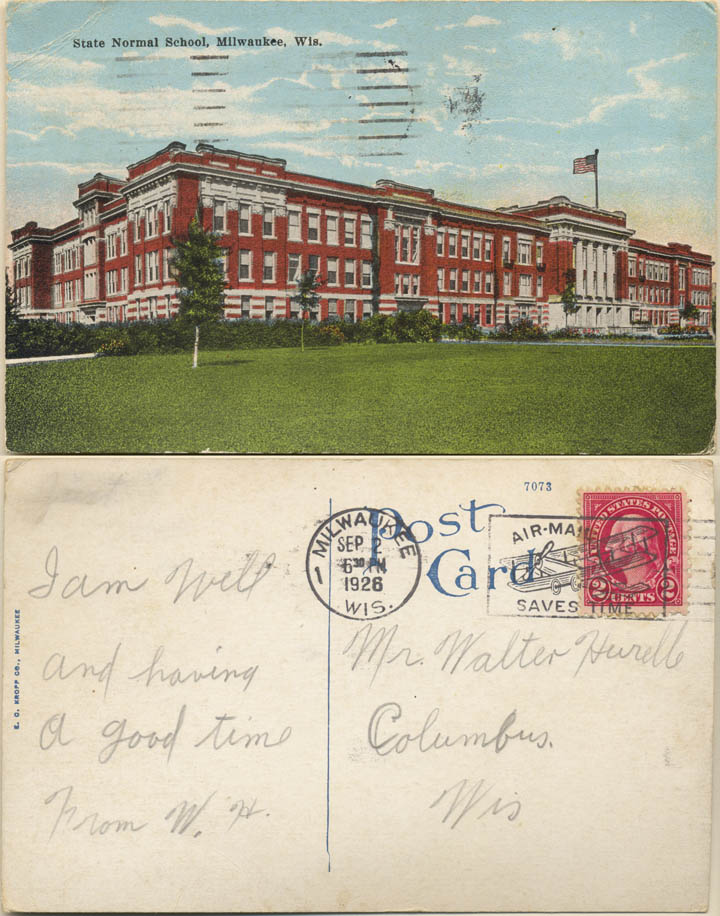
At eight years old in 1926, Willard wrote to his brother Walter while attending the State Normal School in Milwaukee. |
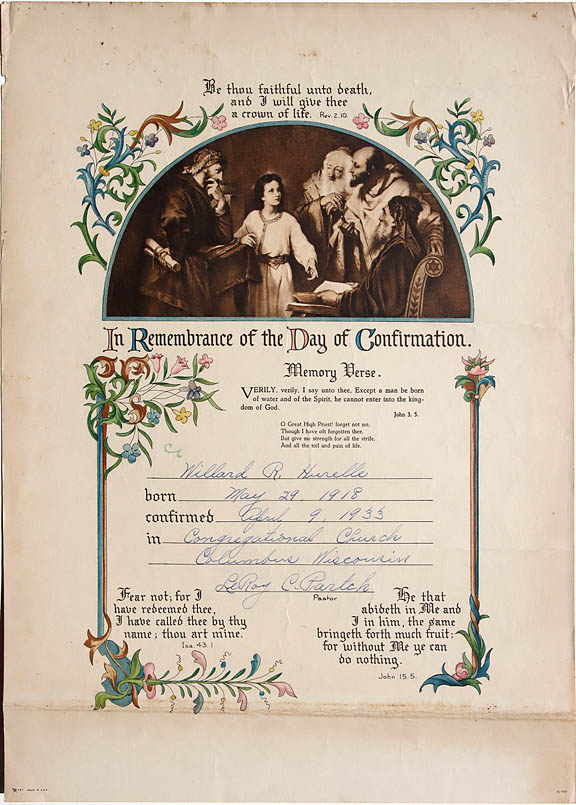 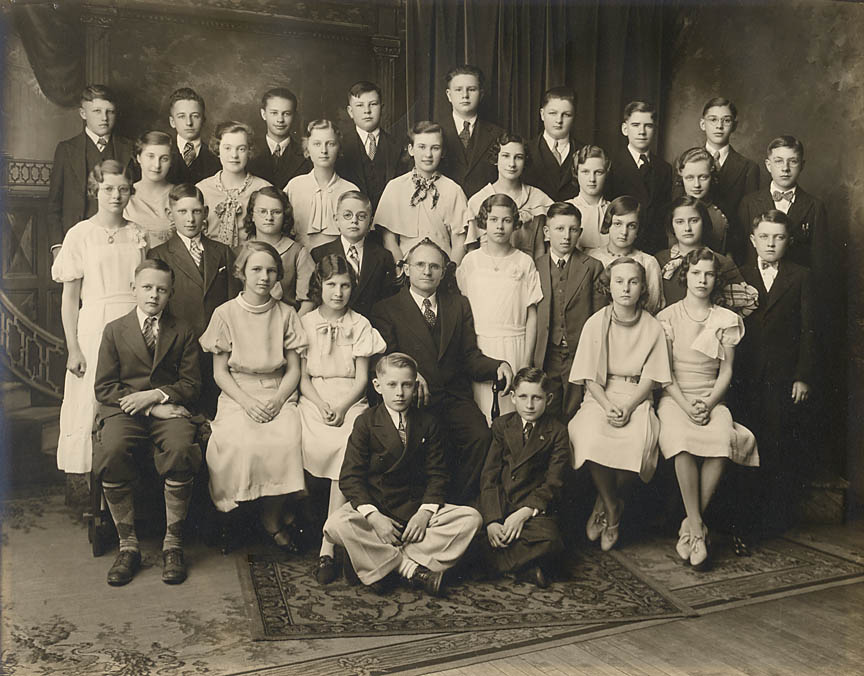
The Day of Confirmation with Willard, top row and center stands tall in his April 9, 1933 Olivet Congressional Church Confirmation in Columbus Wisconsin. Click the photo for names of his fellow church members. |
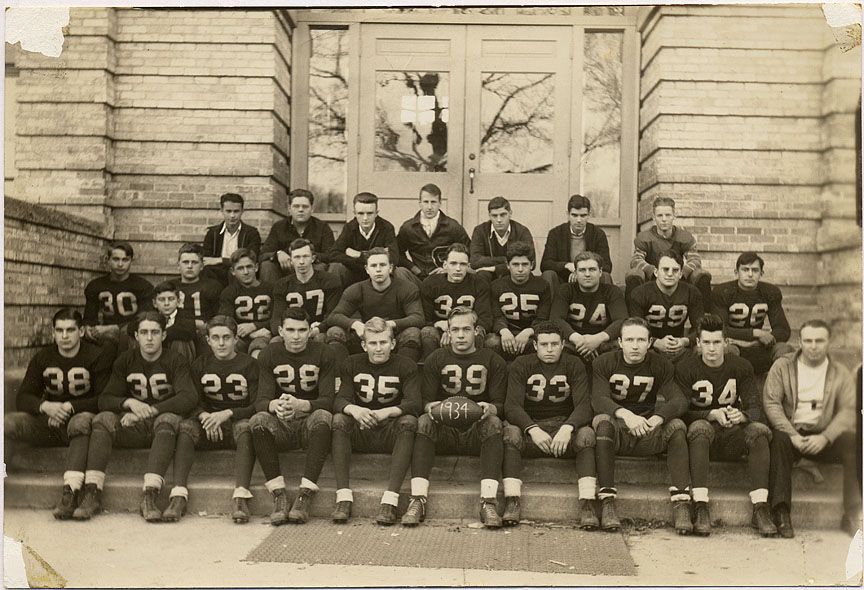 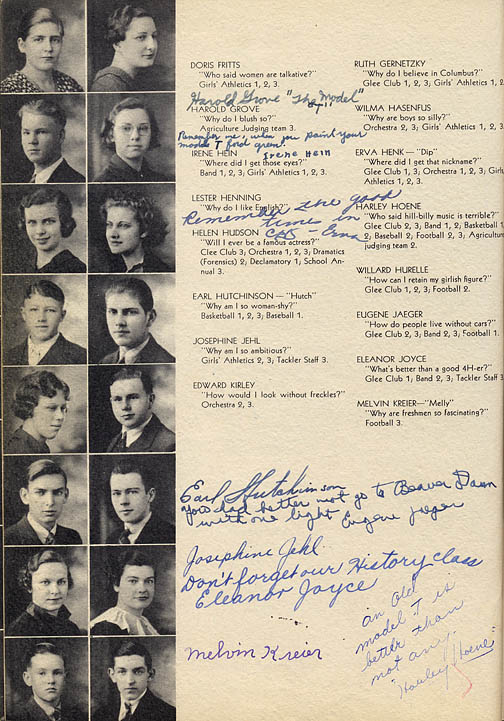
In 1934, Pete's a freshman/sophomore at Columbus High and on the football team (pictured without a number) and his 1936 junior year book page where he was reminded of driving his family's old Model - T, also with just one headlight. |
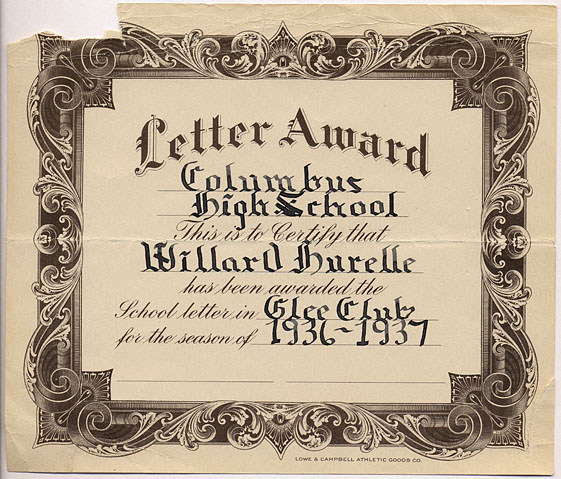 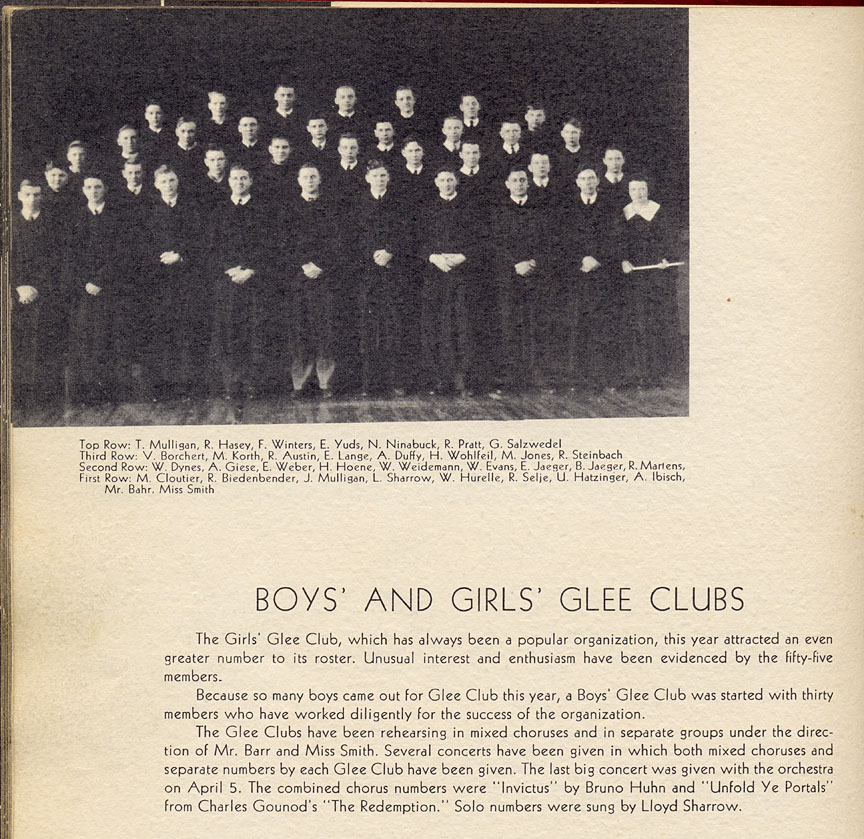
Pete in Glee Club at Columbus High in 1936-7 as a Junior and his year book page describing the Glee Club. |
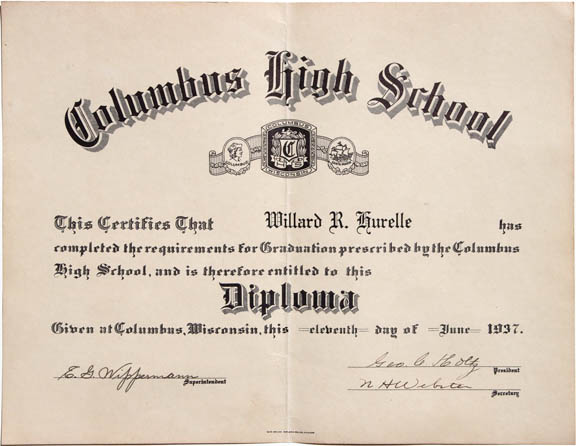
Willard graduates on June 11, 1937 from Columbus High School |
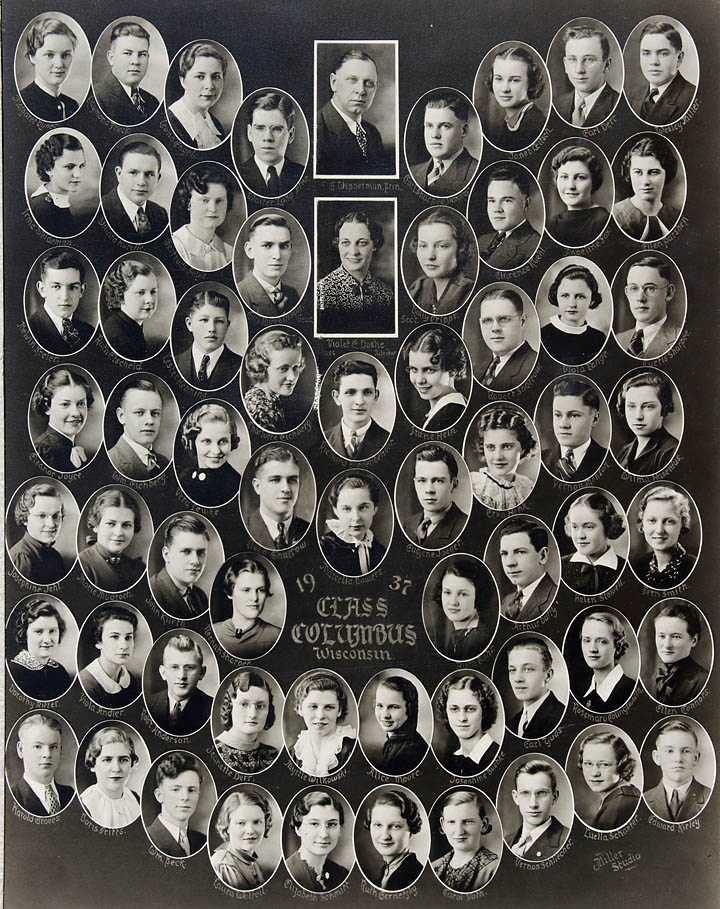
Willard, second row in the upper left, graduates with his fellow class members in 1937 from Columbus High School, Wisconsin |
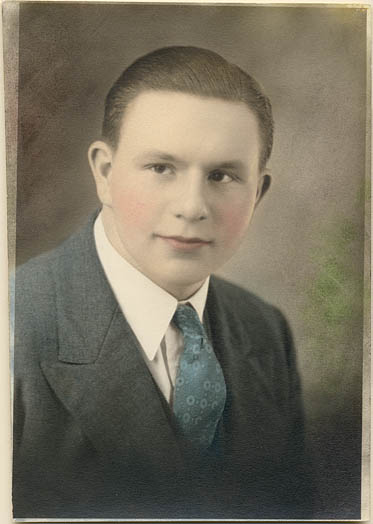
Willard's senior class photo in 1937 from Columbus High School. |

Pete saved the local newspaper while in basic training in active service at Camp Livingstone. The headline in Louisiana's Alexandria Daily Town Talk on December 8, 1941 - "U.S. IN WAR." |
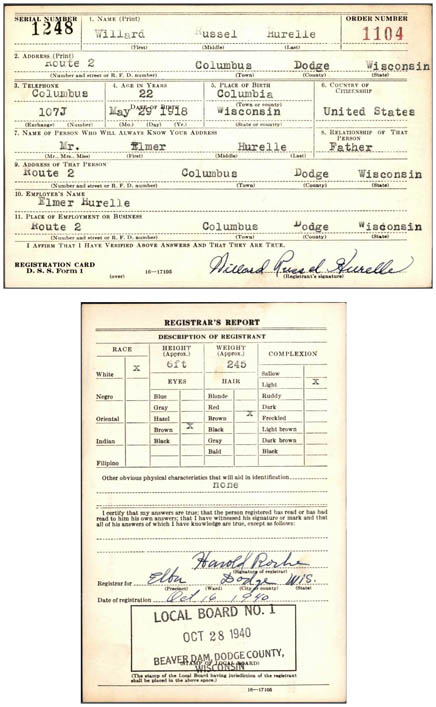
Willard registers for the selective service and the draft the same day his brother does, October 16, 1940. |
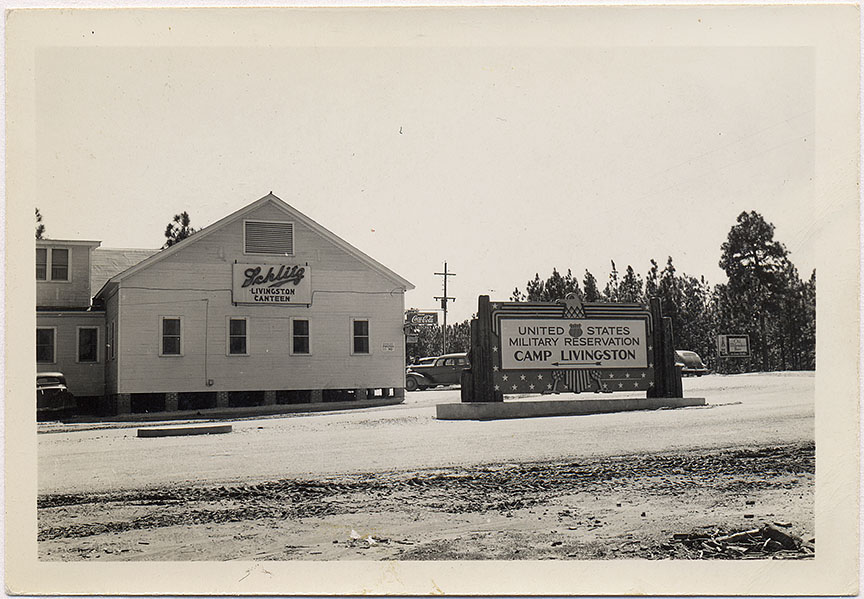
April 17, 1941, at 22 years old, Pete entered active service and basic training in the 121st Field Artillery at Camp Livingston. Notice the Schlitz beer, Coke signs on the Livingston Canteen with the Old Milwaukee Beer sign just off the road. (All military photos are from Pete Hurelle's collection) |
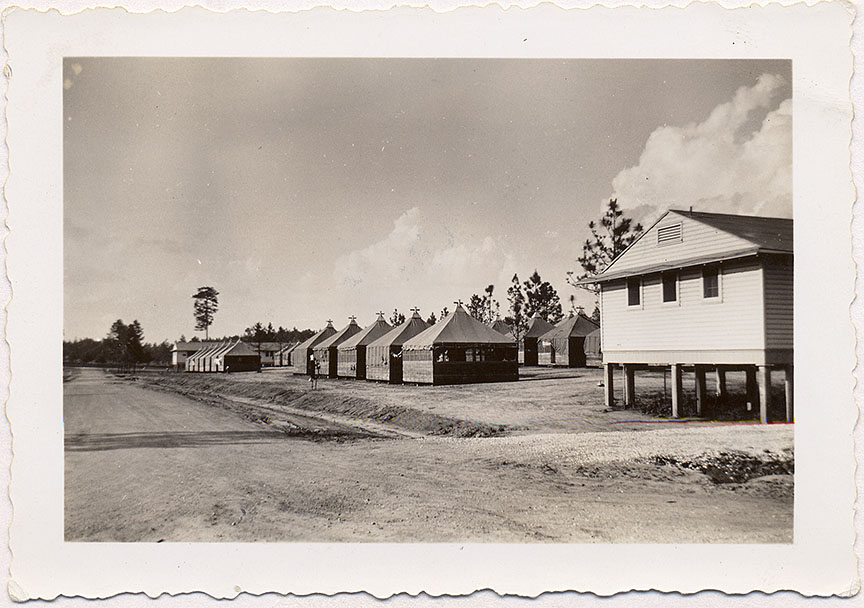
1941 - Enlisted camp quarters at Camp Livingston. |
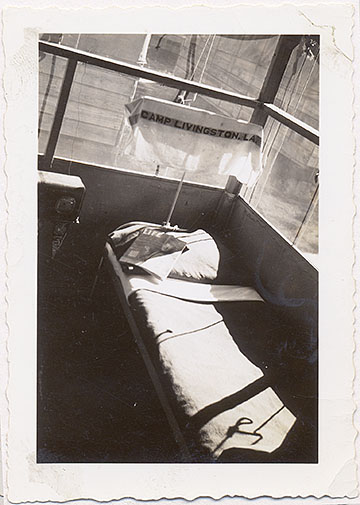 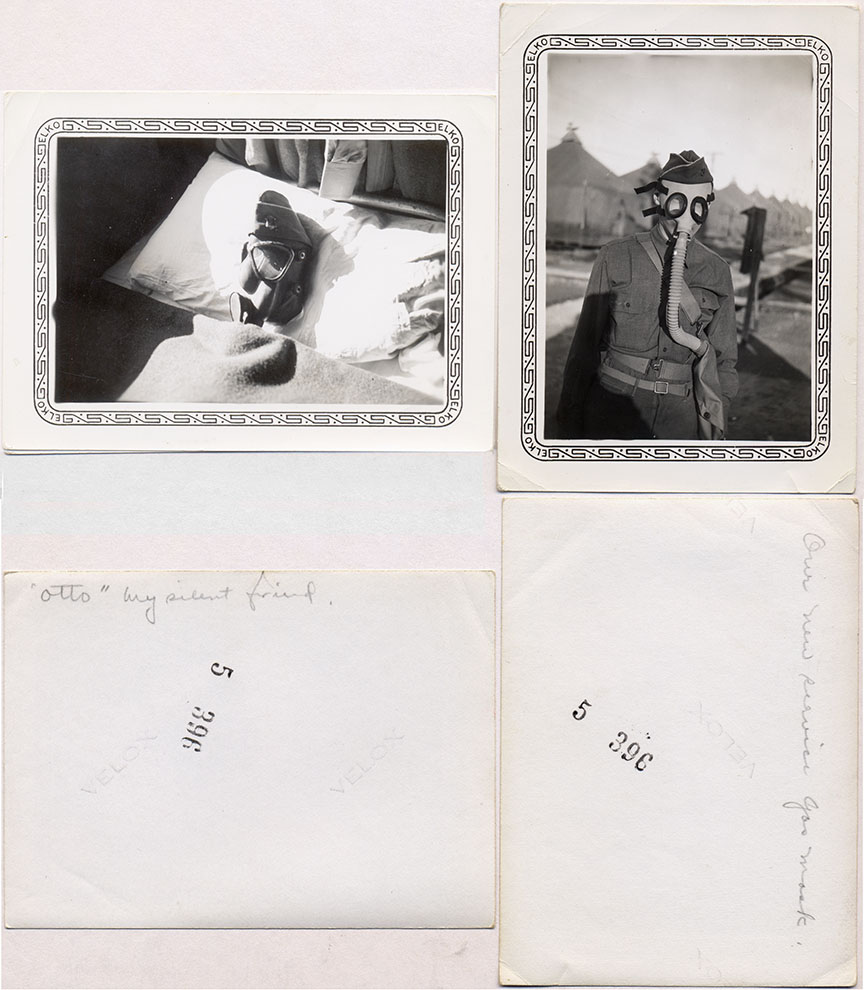
Pete's bunk he called "my corner." Notice the Life magazine, Camp Livingston pennant and radio with the towel drying on the open window. In the future while reading the magazine he would discover the Japanese POW propaganda photo published in Life of his brother and other prisoners in Shanghai, China and learn of the fall of Corregidor.
Always nearby, "Otto" my silent friend" the gas mask. |

In May of 1941, Pete sent his parents a letter thanking them for the cakes and cookies and described camp life, sleeping in the woods during maneuvers, his training in the radio section, gas masks, troop movements and their hazards as well as the casualties, with one soldier dying after being bitten by a coral snake and others being crushed by a tipped over kitchen truck - "its just like real war." |
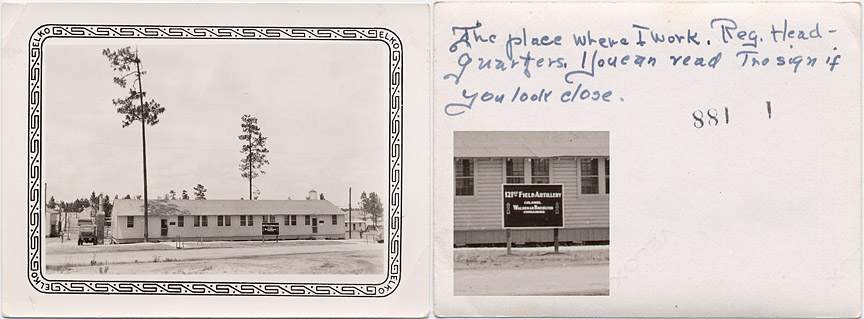
Working at the 121st Field Artillery Headquarters under the Commanding Officer Major Harold K. Nebel. |
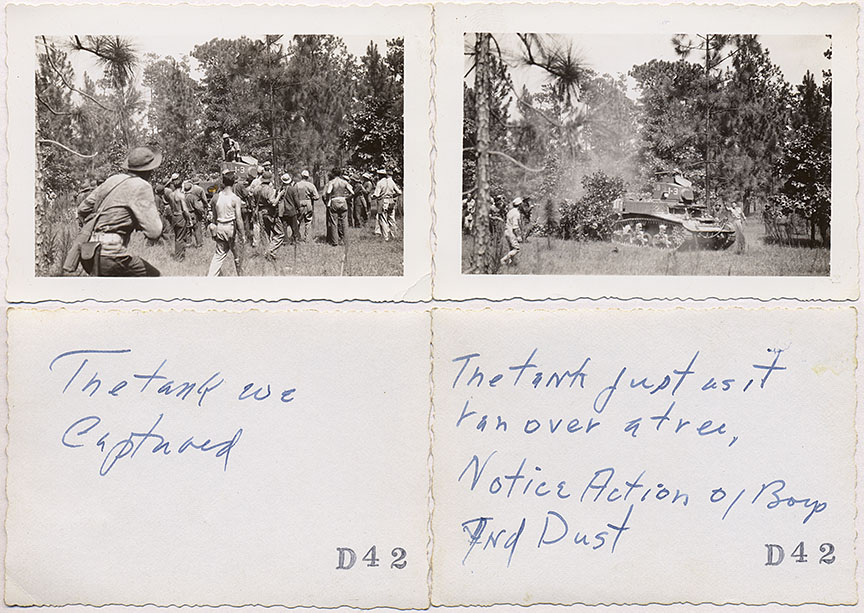
During maneuvers between red and blue armies, they captured the opposition's tank (with the gun barrel removed) with their hand guns drawn and pointed at the tank crew. |
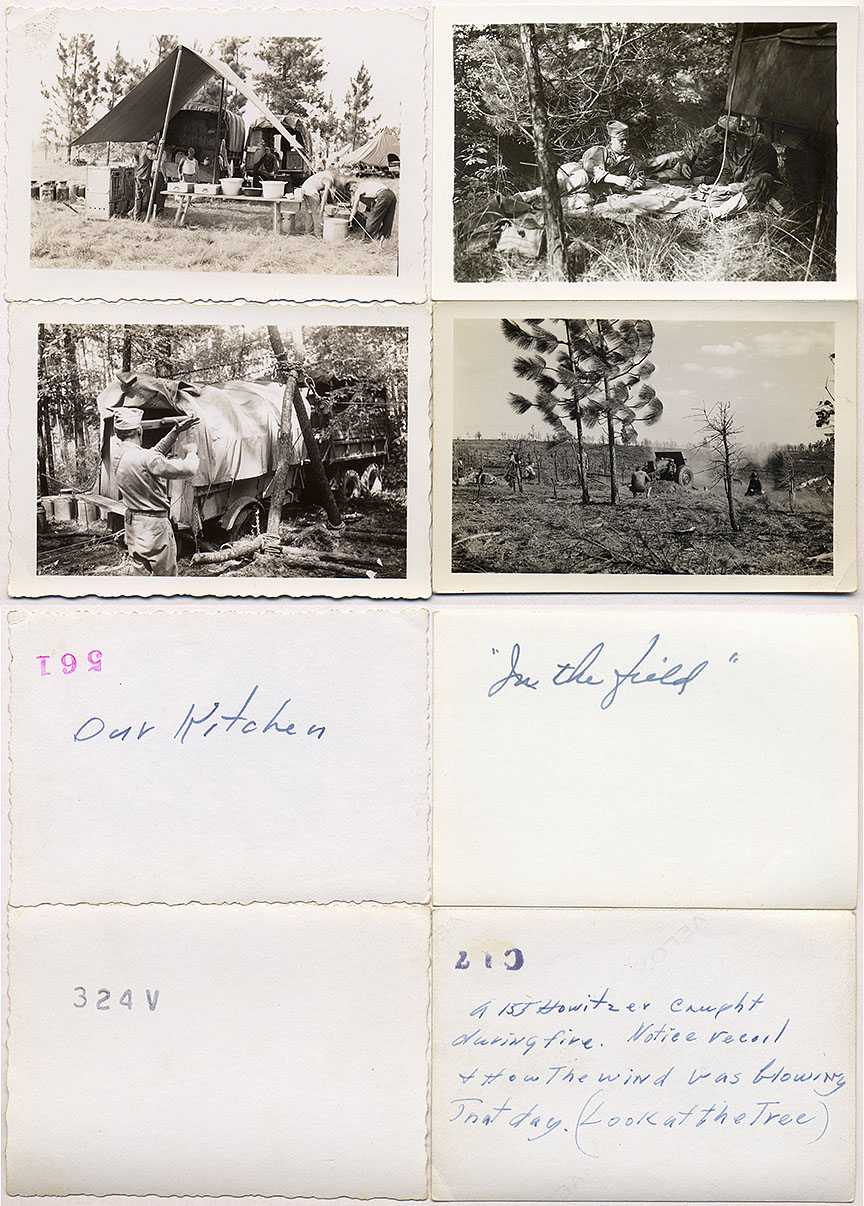
Life during maneuvers, preparing them for the European theater. The kitchen is part of the 121st Field Artillery, Headquarters Section. |
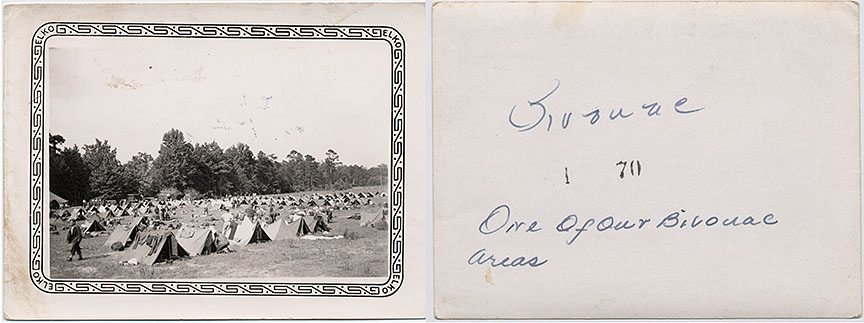
Soldier's bivouac, a small tent city. |
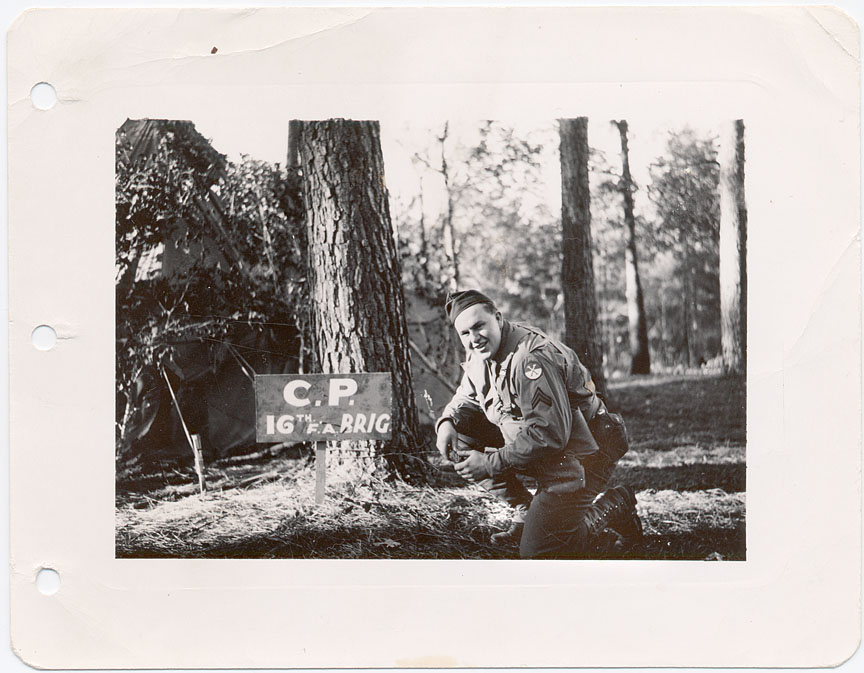
1942 - The 16th Field Artillery's brig during field maneuvers. |
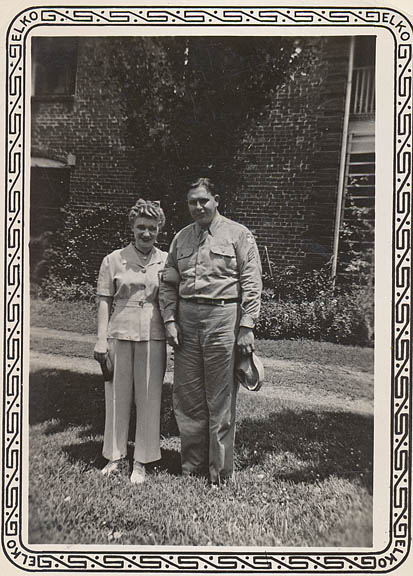
Pete meets Frieda Elizabeth Houseman. In 1943 she was about 1.5 years into her 3 year training as a nurse at Oklahoma Baptist Hospital in Muskogee while living at 514 1/2 Fond du Lac, Muskogee, OK. They are later married on November 8, 1943 in Tulsa Oklahoma, one month before Pete shipped out to the European Theater. |
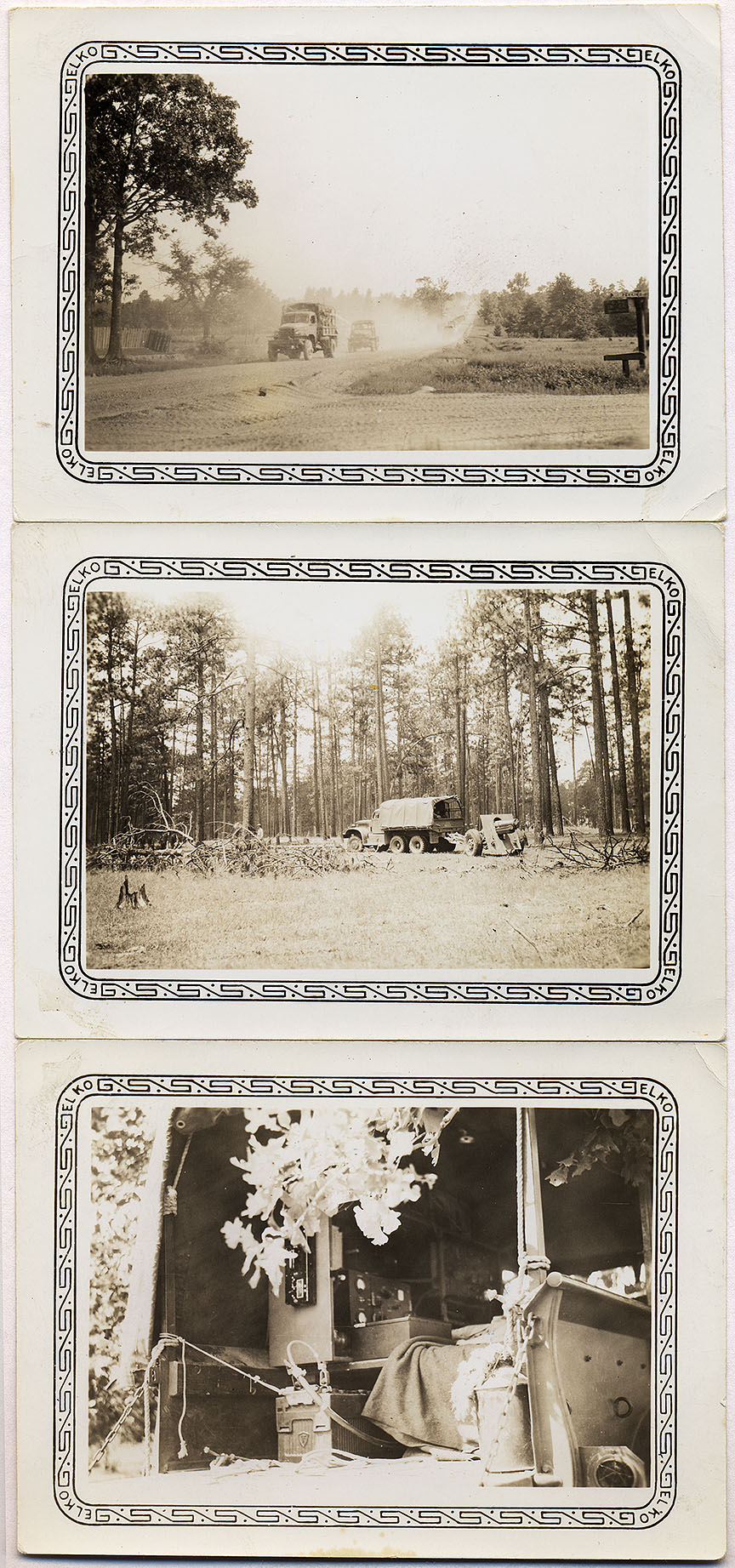
An Army on the move with trucks rolling in a convoy as guns are moved into position. Radio equipment is hooked into a battery. |
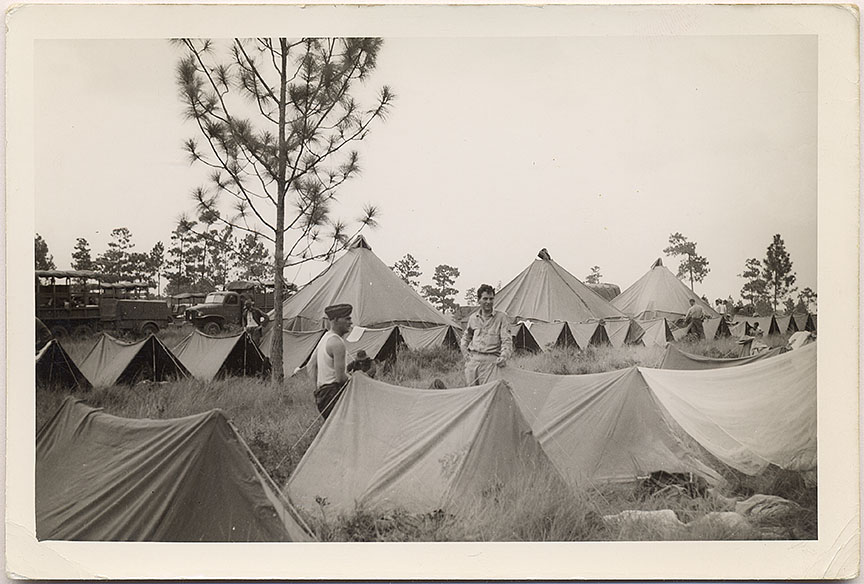
Rows of bivouac tents are set up next to the vehicles. Gro. West and Corporal Robert L Freytag stand among the canvas shelters. |
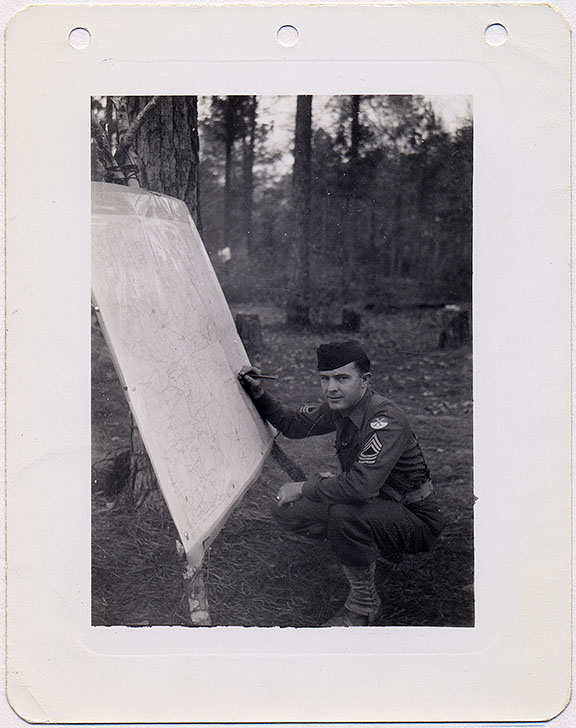
Part of Headquarters Section, a fellow soldier marks the map while on maneuvers. |
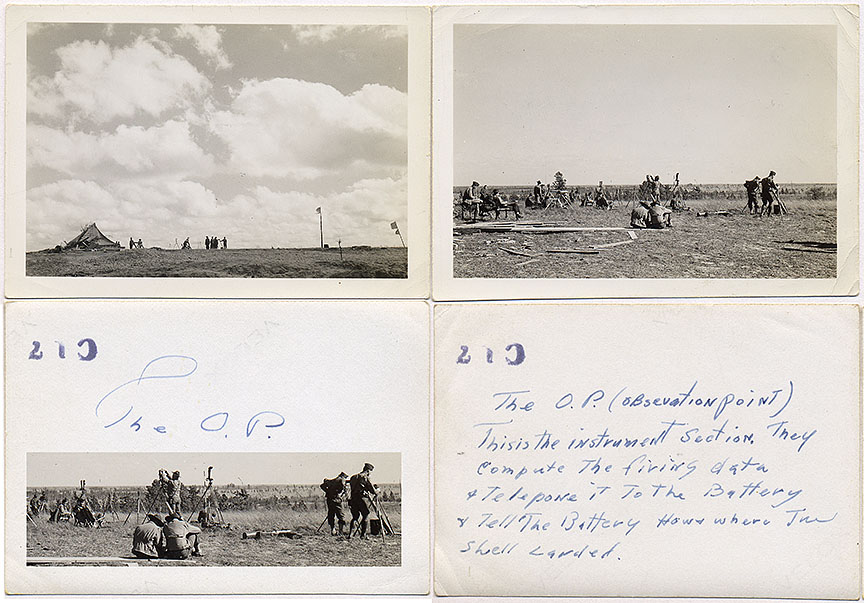
The Observation Point where artillery firing targets are calculated and watched for accuracy. |
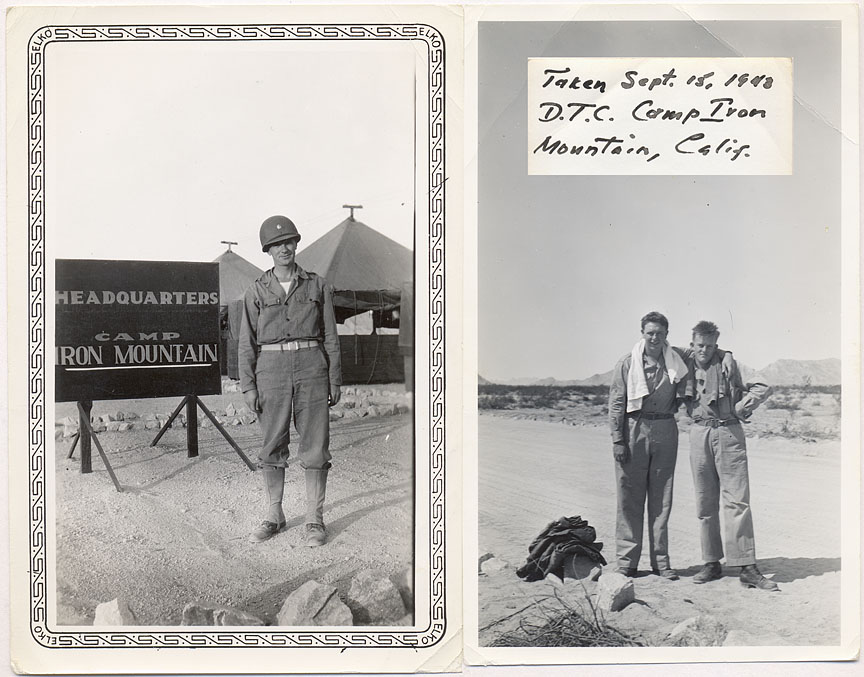
A few months before traveling overseas to England on December 14, 1943, Pete received additional experience at the Desert Training Center at Camp Iron Mountain on September 15, 1943. |
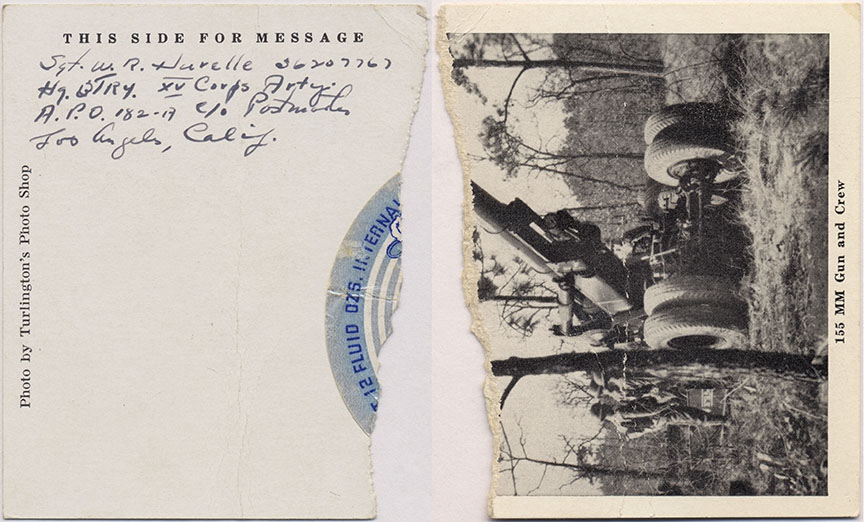
Sergeant W. R. Hurelle's address at the Headquarters Battery of the 15th Field Artillery at Camp Iron Mountain. |
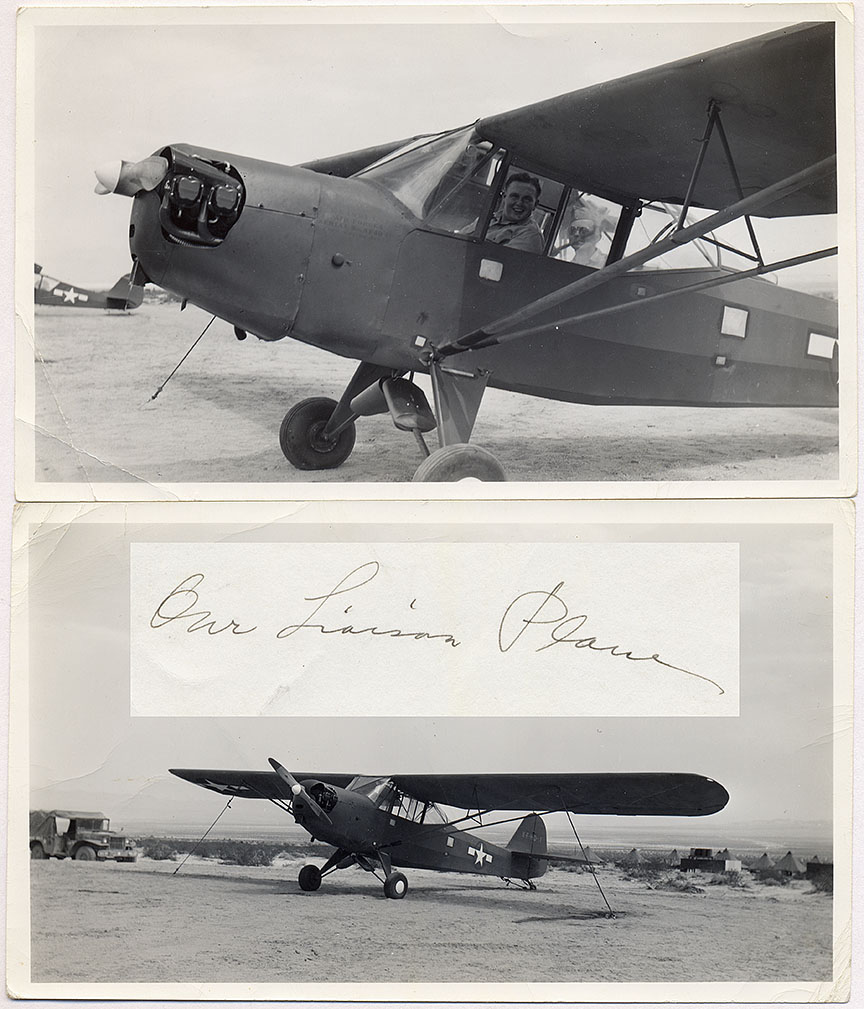
Camp Iron Mountain's liaison plane tethered in the sand with tents in the background. Liaison planes were useful for the military for artillery observation or transporting commanders and messages and made short takeoffs and landings easier. |
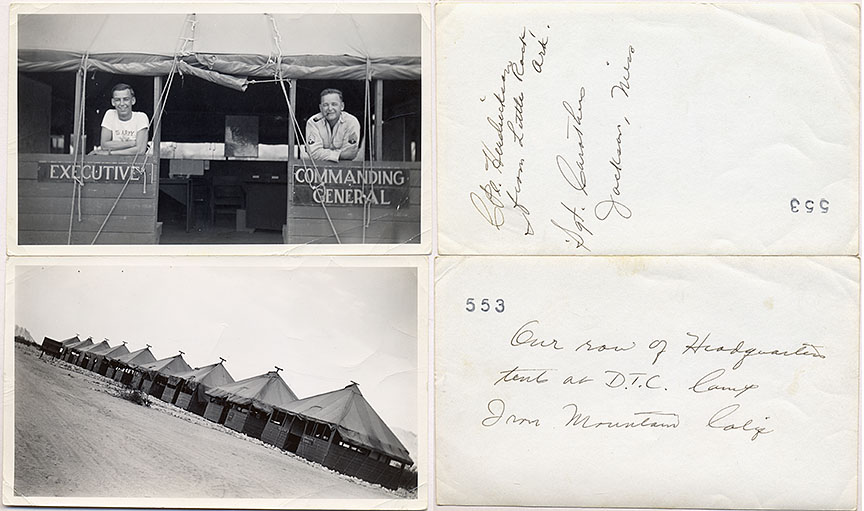
Camp Iron Mountain's Headquarters tents, Pete's U. S. home only for a bit longer. |
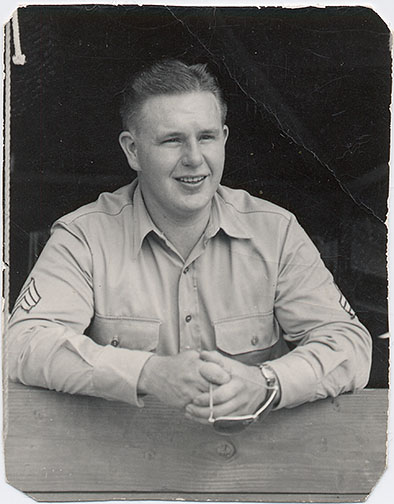
Pete's Camp Iron Mountain portrait. |
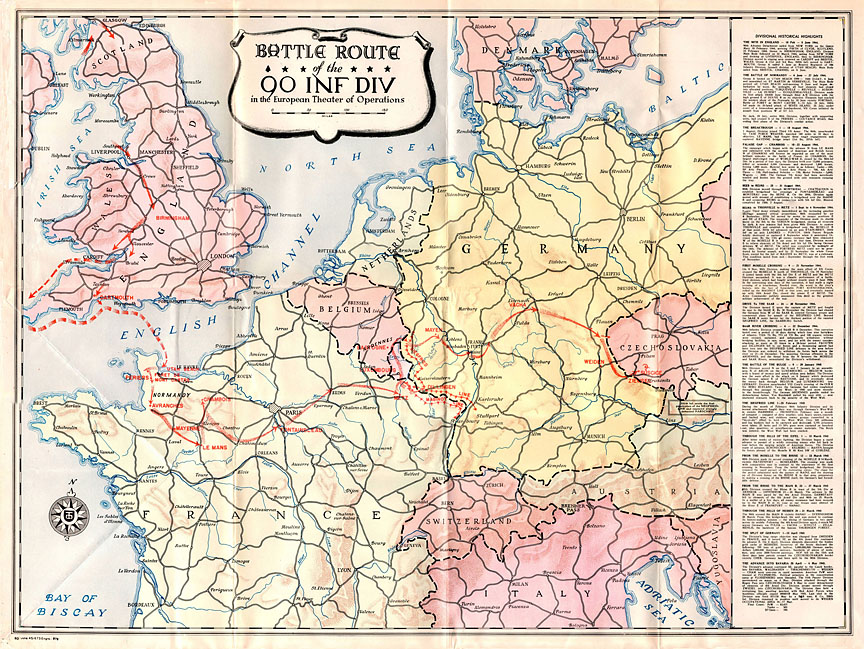
Willard's route with the 90th in the European Theater of Operations.
Map from Major Robert F. Burns 90th site. |
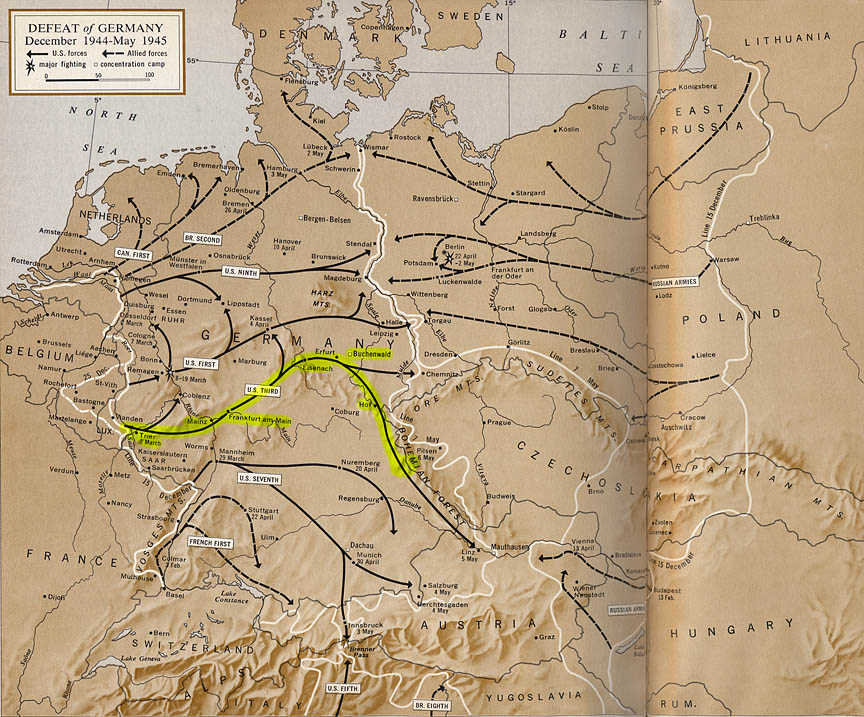
Part of the US Third Armored Division, the 90th with the 359 drive through the central part of Germany to Czechoslovakia - Pete's approximate path is highlighted in yellow. Map from p.558 "The American Heritage Picture History of World War II published in 1966." |
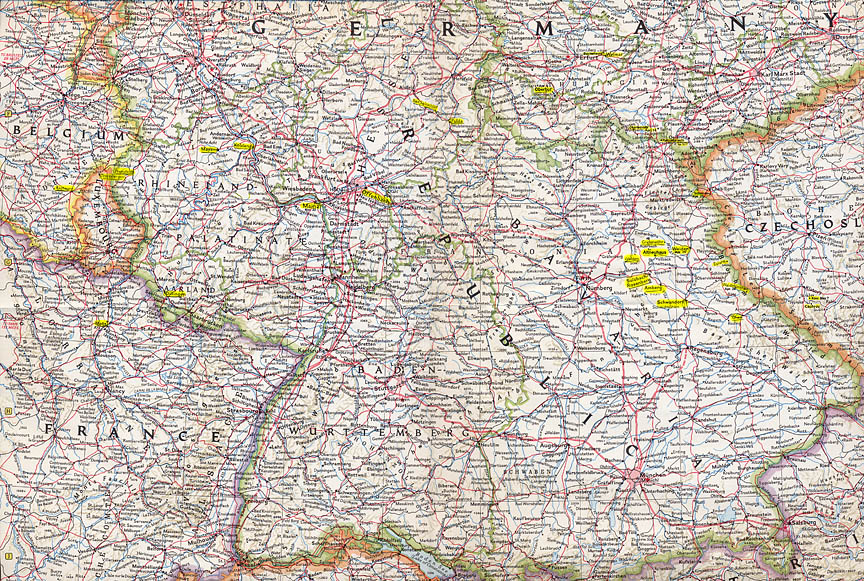
Following the 90th route, Pete with the 359, photographs a few of the towns along the way. Some of the towns are highlighted in yellow on a National Geographic 1959 map. |
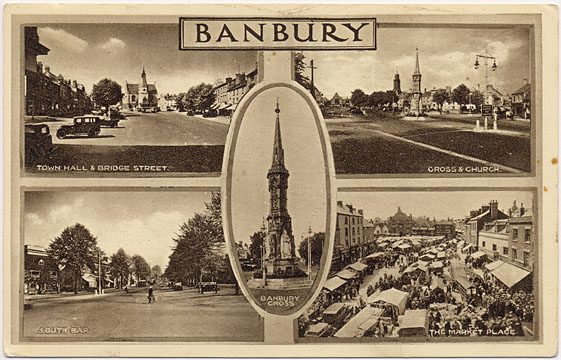
Willard's shipped out to England, perhaps to an area near Banbury, collecting postcards throughout his European route. |
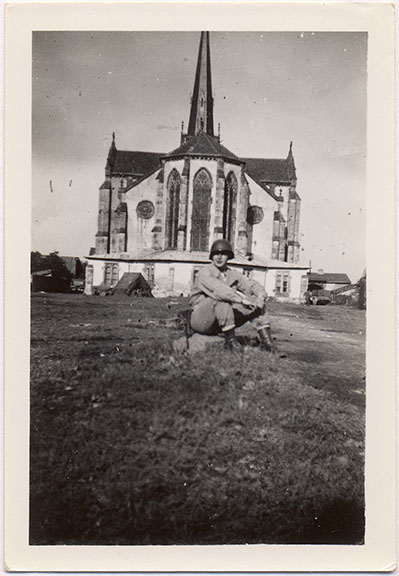
With his sidearm on his hip and helmet on his head, Pete sits in front of a Paris Church. |
The 359th Infantry was assigned to the 90th Infantry Division with campaigns in Normandy, Northern France, Rhineland, Ardennes-Alsace and Central Europe. His training with the 121st and 15th Field Artillery Headquarters would have been useful for targeting the enemy with mobile 105mm Howitzer and 155mm guns.
He would be part of General Patton's 3rd Armored Division of Army forces pushing into Germany.
Pete's Job or Military Occupational Specialty
Operations Sergeant - 814
Operations Noncommissioned Officer (NCO 814)
Enlisted Personnel Assists operations officer in maintaining current military intelligence as to location and strength of friendly and enemy troop units, preparing plans for tactical employment and disposition of troops in attacks against enemy forces and the strategic withdrawal of troops in retrograde movements. Maintains ground or aerial photo map of combat area on which is currently posted all military information received from intelligence units pertaining to location, strength, and disposition of friendly and enemy units, using colored pins, conventional Army signs, and other markers. Maintains diary or log of military activities and other incidents in which unit is involved. Assists in preparation of tactical plans concerning attacks against enemy forces and withdrawal of troops. Supervises typing and clerical work required in preparation of combat orders. Routes combat orders and map overlays to units concerned. Equipment includes drafting boards, drafting pens, overlay paper, stereoscopes used in reading and interpreting aerial photos, and protractors used to locate points on maps. Must know general organization of arm or service to which assigned and be familiar with its tactical employment and technique. Must be able to read maps accurately. Must be able to use stereoscopes and interpret aerial photos. Must be able to prepare map overlays using drafting table, overlay paper, and drafting pens. |
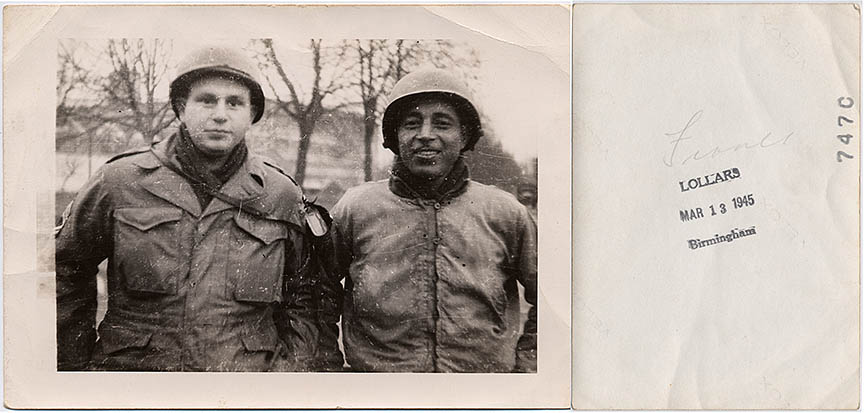
Willard, on the left stands with a brother in arms in France. |
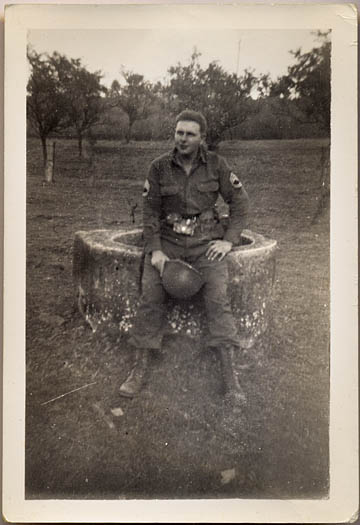
Taking a break in France before moving into Belgium and Germany. |
|
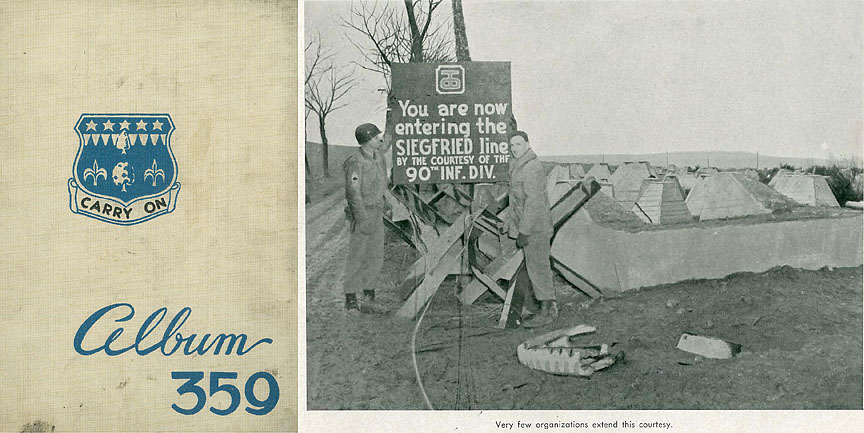
Pete wrote on February 6 -10, 1945 - Habsheid, Germany - here we crossed the Seigfreid Line. Wow!! He continued on the 13th at Heckhalenfeld, Germany, "Here we started the taking of the pillboxes."
More detail was recorded on the 359 Album:
"Remember when we went back to the Siegfried Line again on the 6th of February? The difference in enemy resistance? In most instances it was lighter and weaker, but we caught heavy artillery and tank fire. Will you ever forget the sloshy mud over the tops of your boots as was trudged across the fields turned into swampland by the melting snow? The enemy was pretty low in manpower by now, and a good number of pillboxes were not even manned. Those that were manned had only skeleton crews. We ran into some stubborn cases occasionally, hut on the whole, the Siegfried Line was overrun fairly easily, and in a little more than two weeks it lay behind us to become one more of our unforgettable memories. We now continued the task of pursuing the retreating Germans."
Earlier, the Seigfried Line was much more difficult to cross. The 359 Album described the fighting:
"The 90th Division had to fight for every foot of ground to the Saar River at Dillingen. Fighting through one of the thickest belts of pillboxes in the Siegfried Line was probably the most difficult battle the 359th Infantry went through. Enemy weapons of all kinds were zeroed in on the entire area. Cold, sleet, snow, frostbite, frozen feet and hands, as well as terrific enemy small arms and artillery fire, made this campaign one of the bitterest ever fought. Remember how the companies, battalions, and regiments, fought desperately for their strategic positions? Enemy troops would infiltrate and recapture pillboxes we had once fought for and won. It took the combined efforts of our biggest and best guns, including the 240, to neutralize the pillboxes." Then came the "Bulge", and the 90th was ordered to shorten its lines and draw back to protect its flanks."
"Moving to the southern side of the "Bulge" on the 7th of January 1945 the 90th went to the assistance of our beleaguered troops, who were disorganized by the sudden fury of the "Bulge". On the morning of the 9th the 359th Infantry went into the attack. Hampered by snow and cold, as well as by seasoned enemy troops the forward progress of our regiment was somewhat impended. The fanatical hopes of the enemy to reach the sea, had to he beaten out of him slowly but surely. In spite of heavy losses, the regiment drove ahead through the rolling, forest matted Ardennes. The towns that fell behind one by one were: Berle, Longvilly, Troisvierges, etc . . . Finally after three weeks of sweating, freezing, and fighting under the most difficult conditions and terrain, the "Bulge" was gone. The final effort of the German Army had been stopped, and bleeding and dying, Germany knew she would never rise again. She knew now that she was fighting against a superior army, and her resistance had slowed down considerably after the "Bulge"."
Album published in 1945 from the Bangor Public Library in Maine.
|
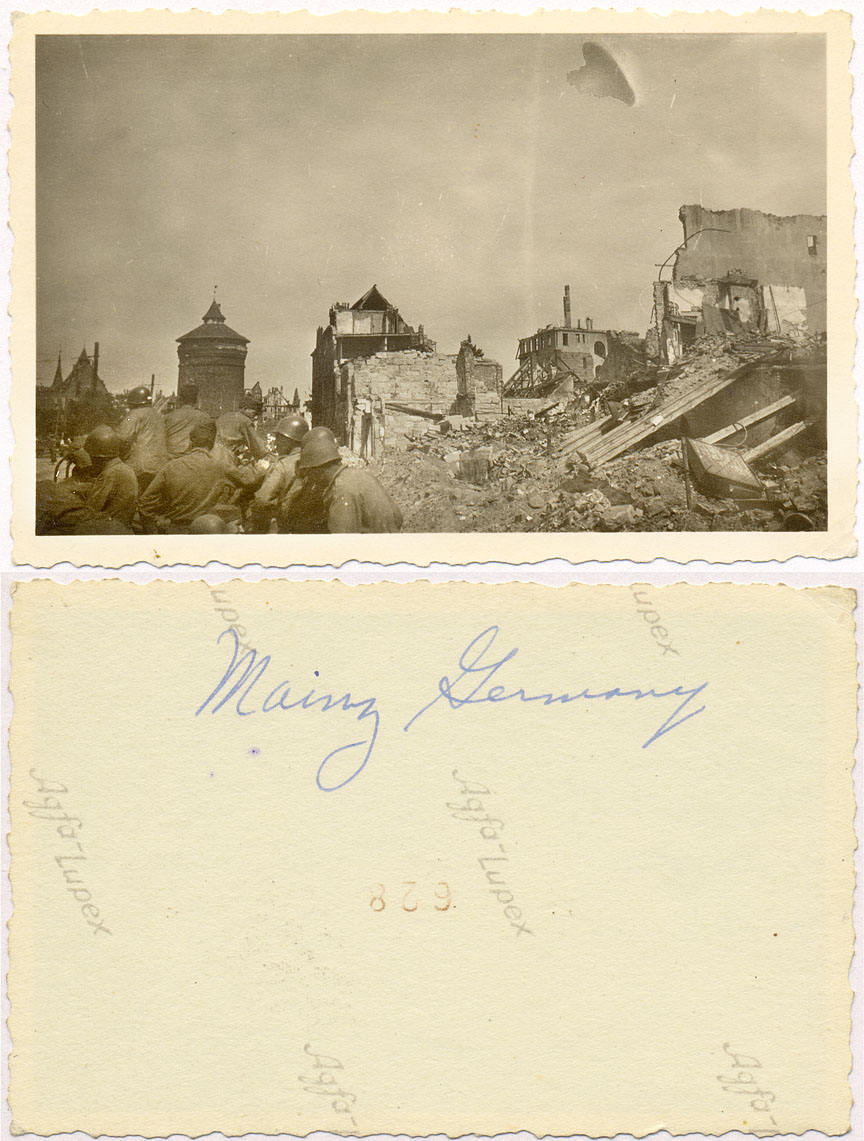
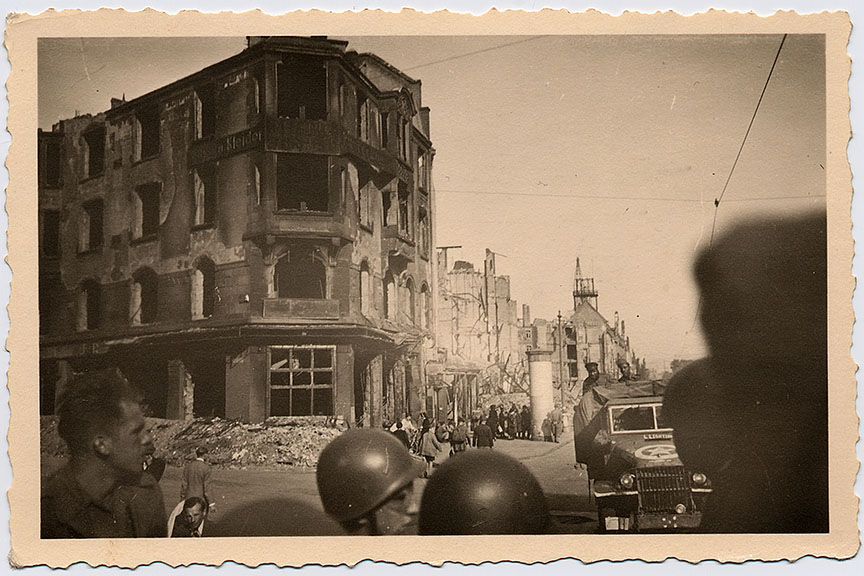
Destruction in Mainz, Germany as U.S. Army troops rolled by in troop transports as townspeople walked the cleared sidewalks near piles of debris. Pete took the photos from the open back of one of the many trucks carrying their headquarters platoon. Pete wrote on his town list for Mainz, Germany on March 22: "I am sure you will never forget this date."
According to the 359 Album:
"On the 22nd March 1945 the attack on Mainz was begun. It was thoroughly bombed from the air previously, and even while we were on the march to the city, our artillery was pounding the edge of Mainz to a pulp. Fanatical resistance was met in the rubble of bombed buildings, but large numbers of Germans surrendered when they saw it was hopeless to continue the fight. Our losses in Mainz were light although sniping by enemy troops was frequent throughout the city. Moving from pocket to pocket, the regiment cleared the city and a path to the Rhine." |
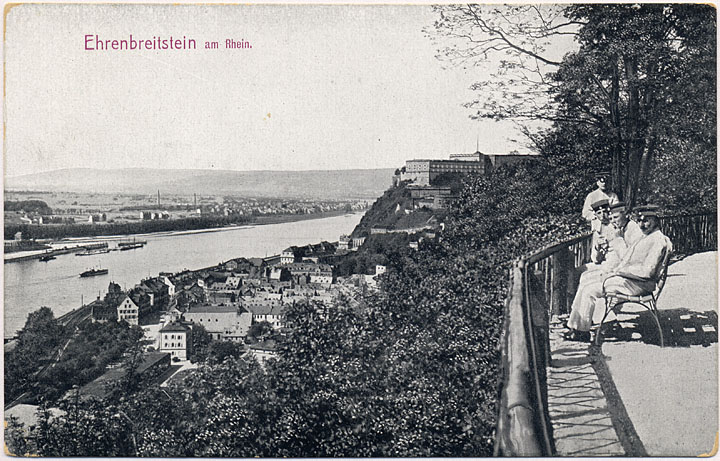
On the west side of Germany at Koblenz, the fortress of Ehrenbreitstein stands on a bluff overlooking the Rhine River. Soldiers sit at another high point at Fort Astersein.
According to the 359 Album:
"On the morning of the 24th (March 1945), we crossed the Rhine on a pontoon bridge at Nierstein. Remember when the "Heinie" planes attempted to strafe us on the bridge? They were chased away by very effective anti-aircraft fire, and several were shot down. After the crossing of the Rhine, the whole backbone of the German Army seemed to he broken. We went through town after town, meeting only very slight resistance, and on some days we would take as many as 5 towns without a shot being fired." |
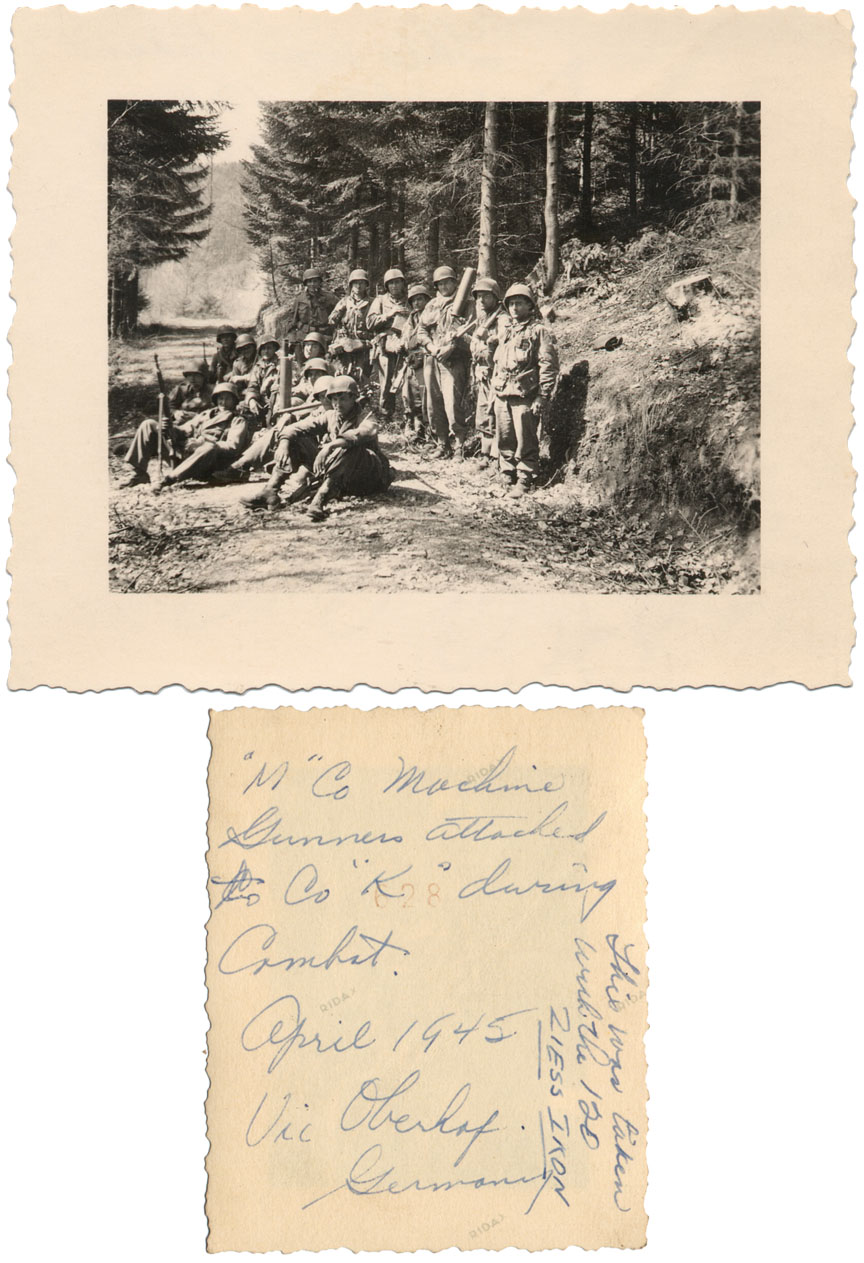
'M' Company Machine Gunners attached to Company 'K' during combat. April (6th) 1945 Vic Oberhaf, Germany - On the way to the Czech border. At a later time, Pete wrote the photo was "taken with a 120 Ziess Ikon." Cameras must have been rotated through the troops as many of his photos were taken with a variety of cameras and film sizes. On his town list for 6 April 1945 he wrote "Oberhof, Ger (The big Ger(man) Winter Resort - 1 Mi SE of Oberhoff - (Here is where we slept out for a couple of days)"
359 Album: "On approaching the Czechoslovakian border, however, the enemy resistance stiffened. We encountered some of the so-called "Hitler's Brats". Remember the 15 and 16 year old kids that were put up against us?"
Pete also confirmed the resistance writing on 12 April in Lichts, Germany "Lt Stone was hit at this time when we stayed at Swandorf" and later wrote on 21 April in Schirnding Germany "We had a rough one here. About 20 Cas(ualties) We missed you." ("you" probably referring to M Company Machine Gunners pictured above at Oberhof.) |
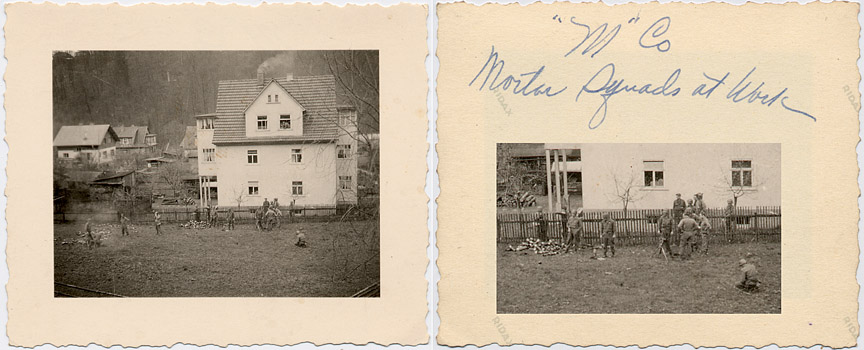
'M' Company Mortar Squads at work in Germany most likely near Oberhof where they encountered resistance in April, 1945. |
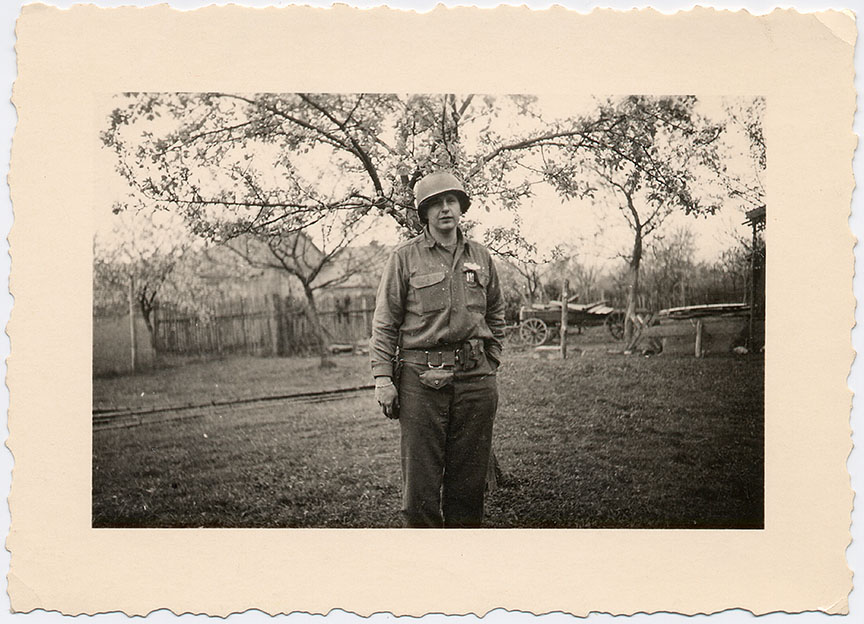
Pete, with pens in his pocket and right hand on his sidearm holster, stood in a rural setting in eastern Germany, again probably near Oberhof with a wooden wagon in the background.
He would soon pass south of the town of Weimar and most likely not see it's nearby concentration camp horrors with open mass graves and bodies stacked like cord wood. The prisoners at Buchenwald, just northeast of Oberhof were liberated after a patrol from the 6th U.S. Armored Division (Pete was in the 3rd Armored Division) on April 11, 1945 rolled in as the German guards and officers fled. The camp contained an official department for medical research where hundreds perished each month from disease, malnutrition, exhaustion, beatings, and executions. Most of the prisoners were starved and worked to the point of death in nearby stone quarries. Camp records indicate that throughout its existence some 240,000 prisoners from at least 30 countries were confined at Buchenwald concentration camp. (Photos in 359 Album on pgs. 180-1) |
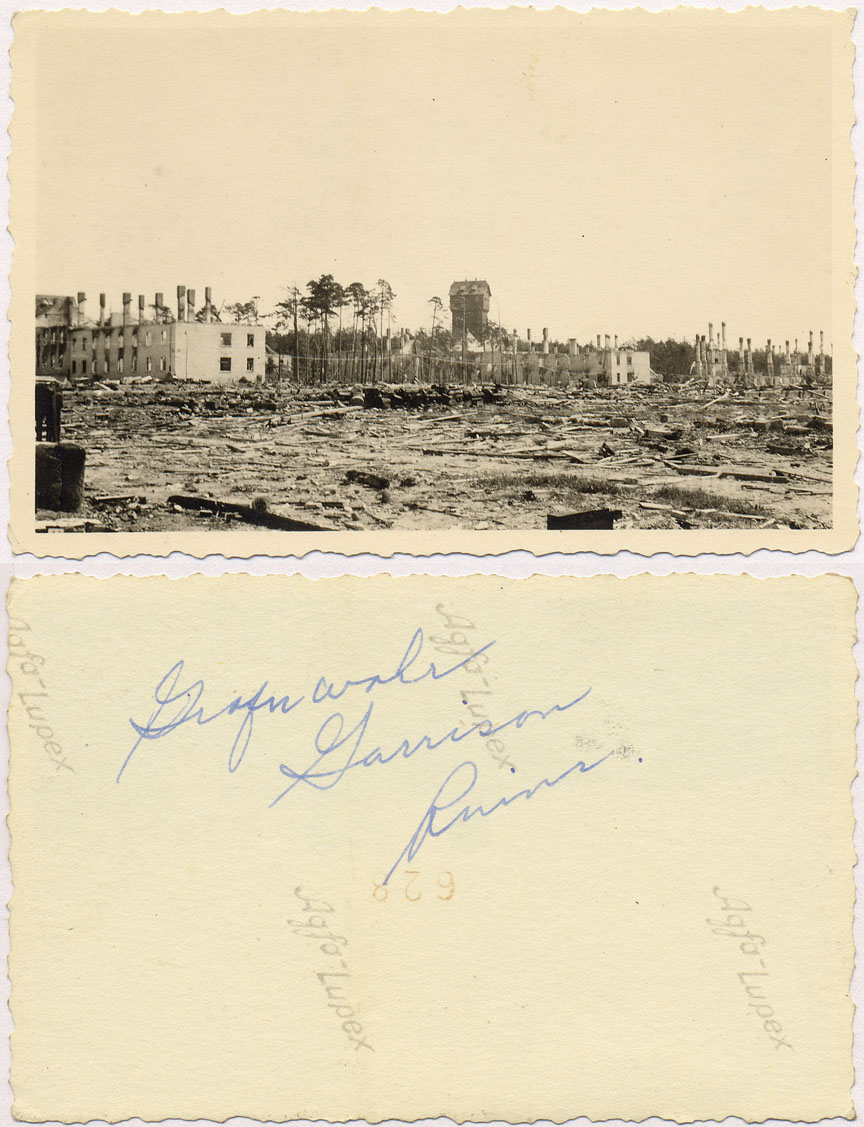
Southwest of Oberhof, the German garrison at Grafenwohr lies in ruins. Surprisingly, a very tall wooden structure in the background survived the bombardment. Grafenwoehr was the target of Allied air raids April 5 and 8, 1945 which killed several hundred people and destroyed many buildings. After Germany's surrender in 1945, U.S. forces took control of the training area and today it remains a United States Army military training base, a 90-square-mile training area - the largest overseas training facility in the Army. |
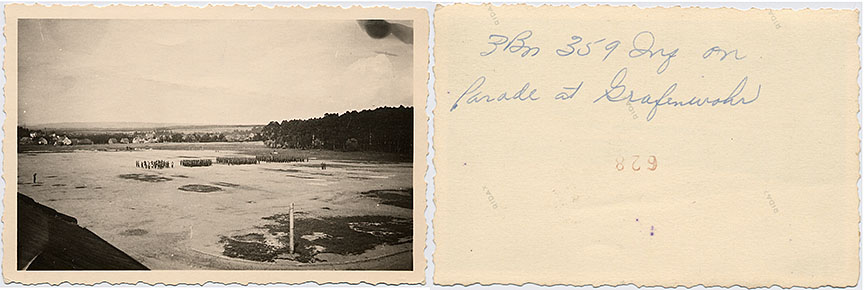
3rd Batallion 359 Infantry on parade ground at Grafenwohr, Germany about April 25, 1945. |
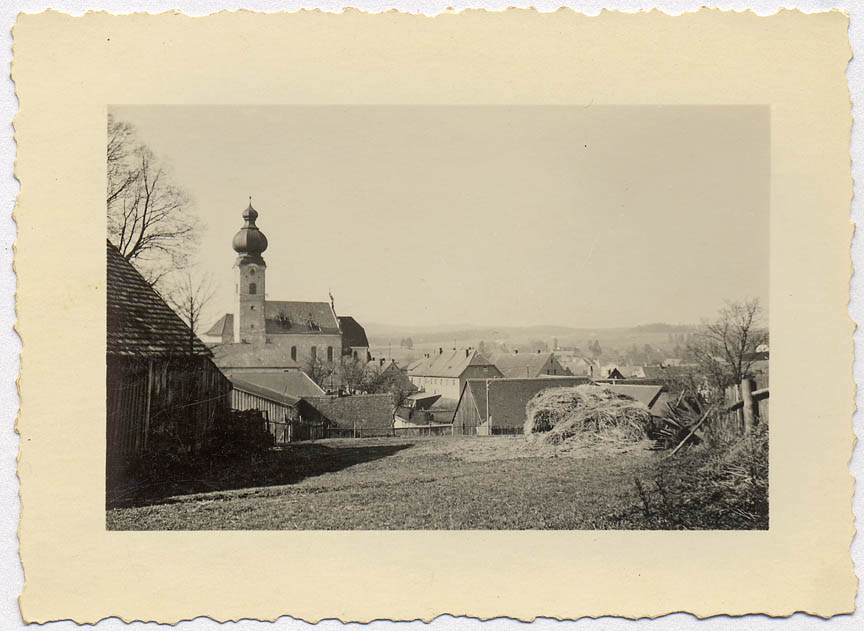
On April (26th ?), 1945, Pete photographs the town of Eslarn, right near the Czech border in Bavaria. The Church of the Assumption - Catholic Church still remains today with new paint and a fixed roof. The church was originally built in 1689, the tower replaced in 1722 and the onion dome added in 1927. (No inscription on back) |
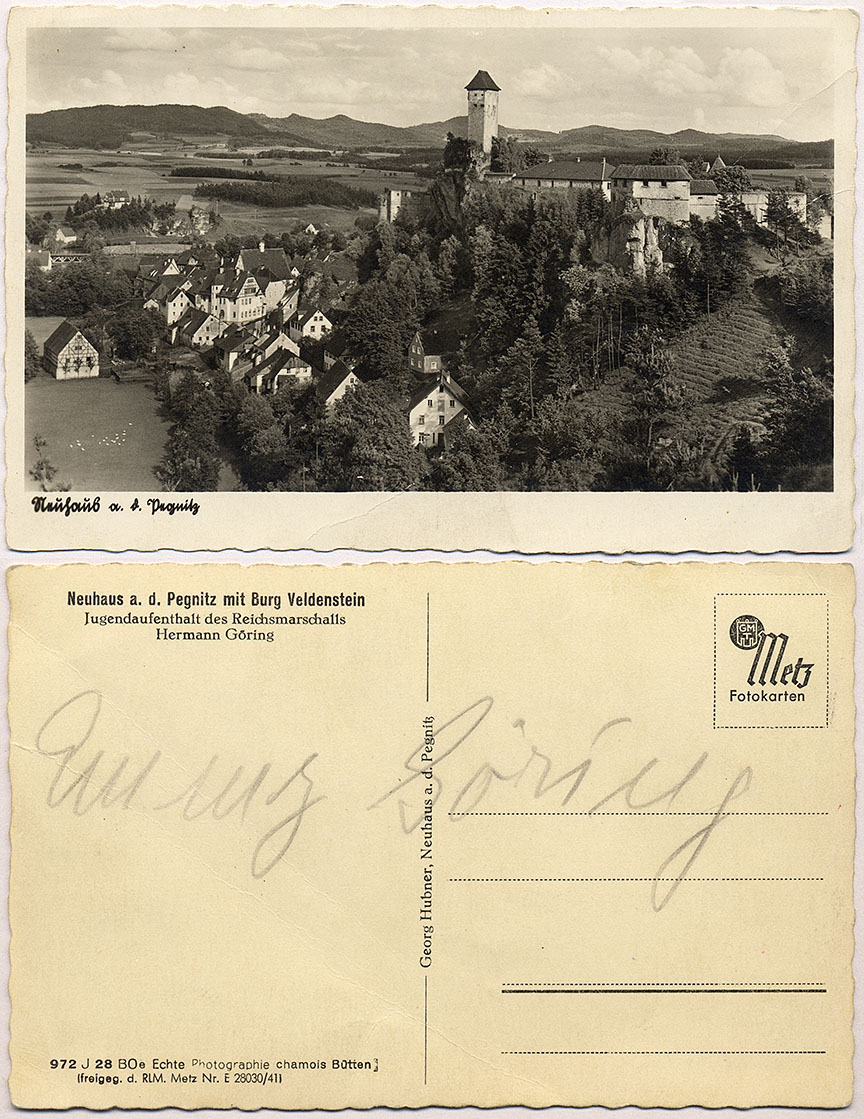
Just northeast of Nurnberg and south of Grafenwohr, Veldenstein castle (Velden on 1959 German map above) at Neuhaus was the childhood home of Hermann Goring, a notorious leader of the Nazi Party and one of the primary architects of the Nazi police state. His second wife, Emmy Goring, an actress, was being held at the castle by the Allies at the end of the war and signed the back of the card. |
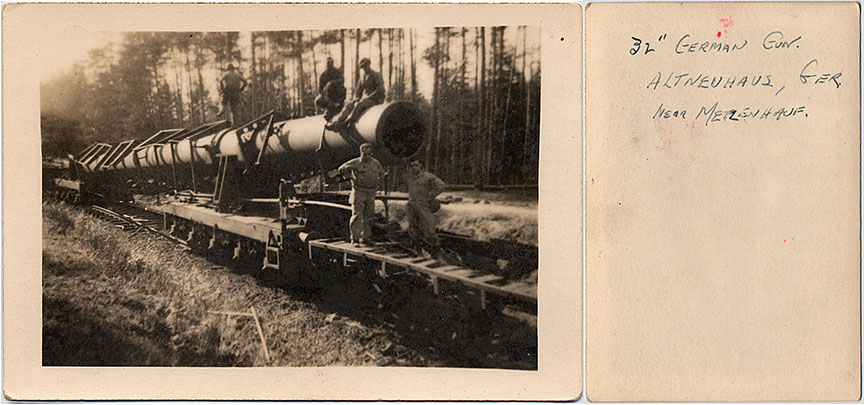
Northeast of Nuremberg, a 32 inch German gun still remained on railroad tracks in Altneuhaus, Germany near Metzenhauf. According to the 359 Album, it was "the largest railway gun, which never got into action." Another photo caption stated "This is supposedly the largest artillery piece in the world, discovered in our occupation area." (p. 200-201) |
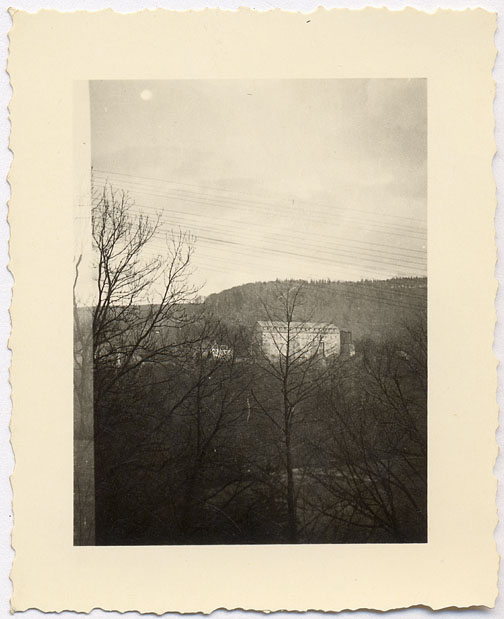 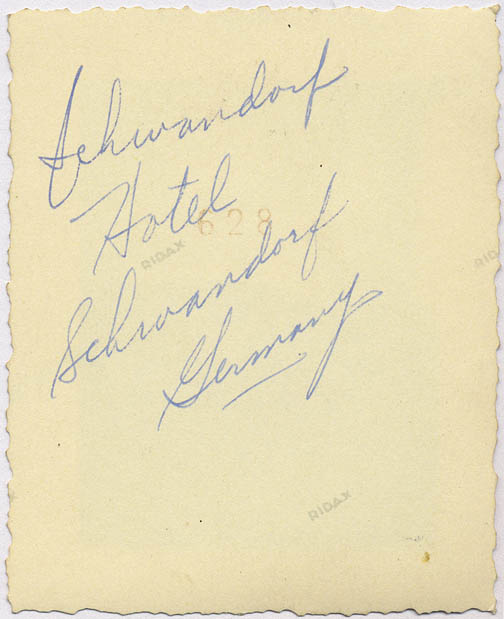
Southeast of Altneuhaus and Amberg, the Schwandorf Hotel stands in Schwandorf, Germany. According to Pete's list, on 12 April in Lichts, Germany "Lt Stone was hit at this time when we stayed at Swandorf." |
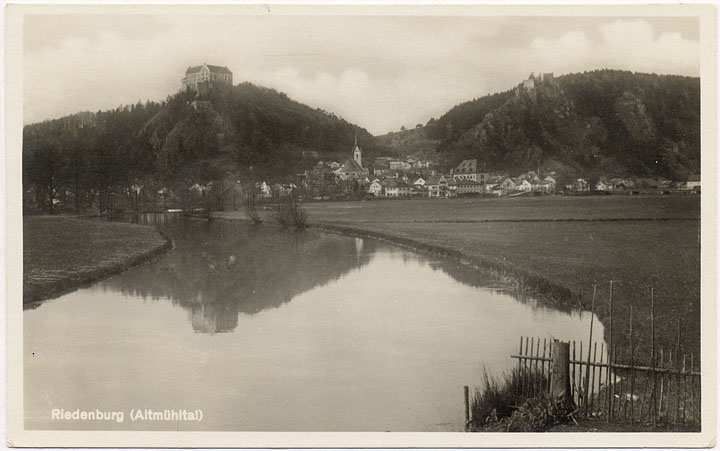
Southeast of Nuremberg in Bavaria, Germany, a 12th century castle sits above the towns of Riedenburg and Rosenberg. The castle today is the Falkenhof Schloss Rosenberg Institute of Falconry. |
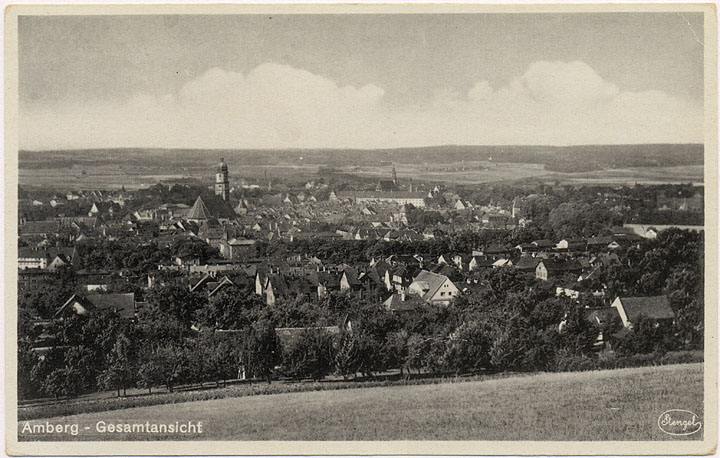
East of Nuremberg in Bavaria, Germany, the town of Amberg was photographed from a hill housing the Sanctuary of Maria Hilf Church. The Pond Barracks in Amberg housed American troops (p. 193 and p. 205, 359 Album). |
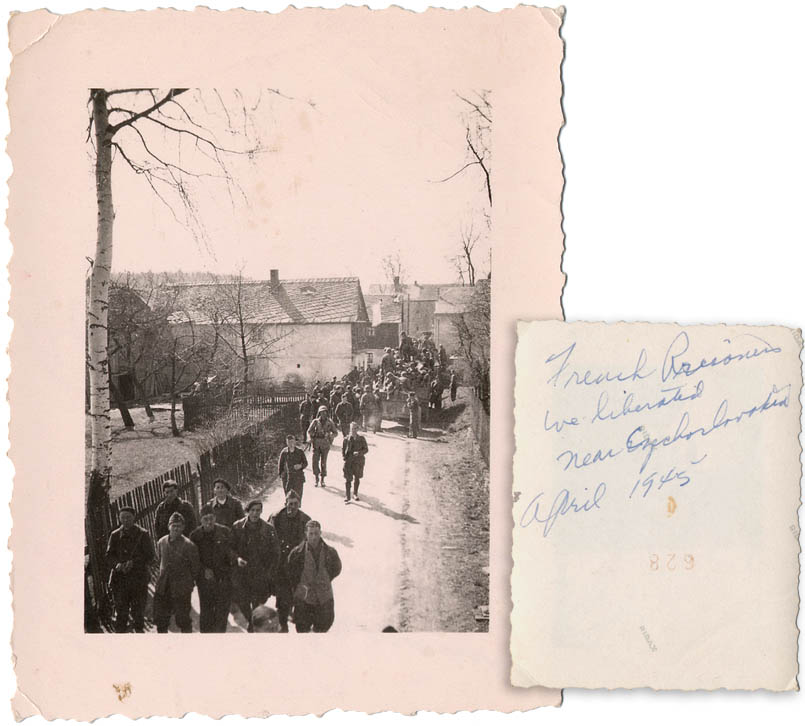
French Prisoners the Americans liberated near Czechoslovakia - Near the end of the war - April or May, 1945 and again taken from the back of a troop transport.
Soon after, according to the Album:
"On May 4th, the 2nd Battalion was near the Czech border when representatives of the German 11th Panzer Division, once one of the best in Germany, came in to offer unconditional surrender. This once proud and mighty division had been reduced to a strength of 9,050 troops, and its armor to one Mark V and six Mark IV tanks. Remember when the troops came in to surrender? They came in an unbelievable variety of vehicles, some of which were being towed by others. Some had broken down on the roads, snarling traffic. Remember the rifles, automatic weapons, ammo, panzer, fausts, and grenades. Remember the rain all that night? It made operations more difficult, and it took days to straighten out the lost and broken-down vehicles." (p.8, 359 Album)
"On May 7th the 1st and 2nd Battalions jumped off into Czechoslovakia on tanks, tank destroyers, and trucks. At 1140 hours word reached the regiment that the German High Command had signed an unconditional surrender. At that time, the regimental CP was in Cachrov; the 1st Bn. CP in Klatovy; the 2nd Bn. CP in Kolinec; and the 3rd Bn. in Radinovy, Czechoslovakia. Remember how you felt when the "cease fire" order was given to all troops? We then occupied the nearest towns to await the formal cessation of hostilities which occured just 11 months and 2 days after the landing on Utah Beach." (More photos of the 359 are available on a Czech website describing the history of the Cachrov region as the American's rolled through in 1945) |
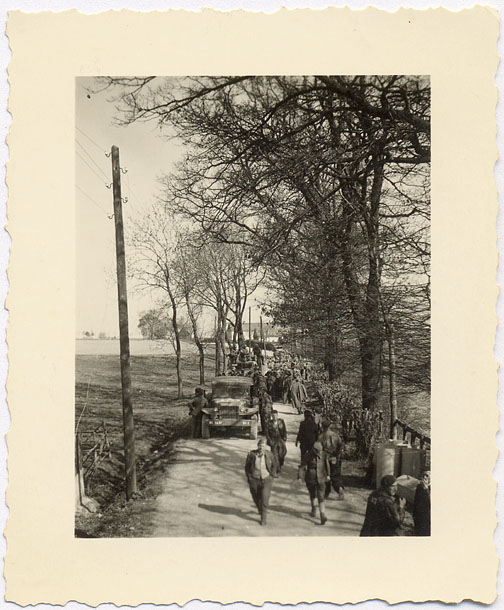 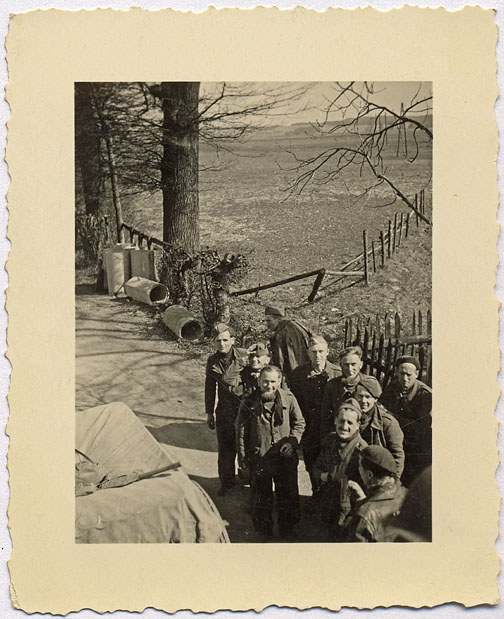 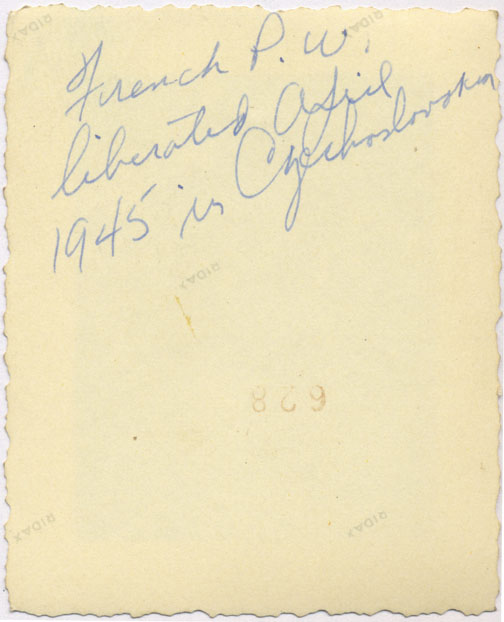
About May, 1945 from a troop transport truck, Pete photographs liberated French prisoners of war as they pass the Army convoy in or near Czechoslovakia. (No description on back of far left photo) |
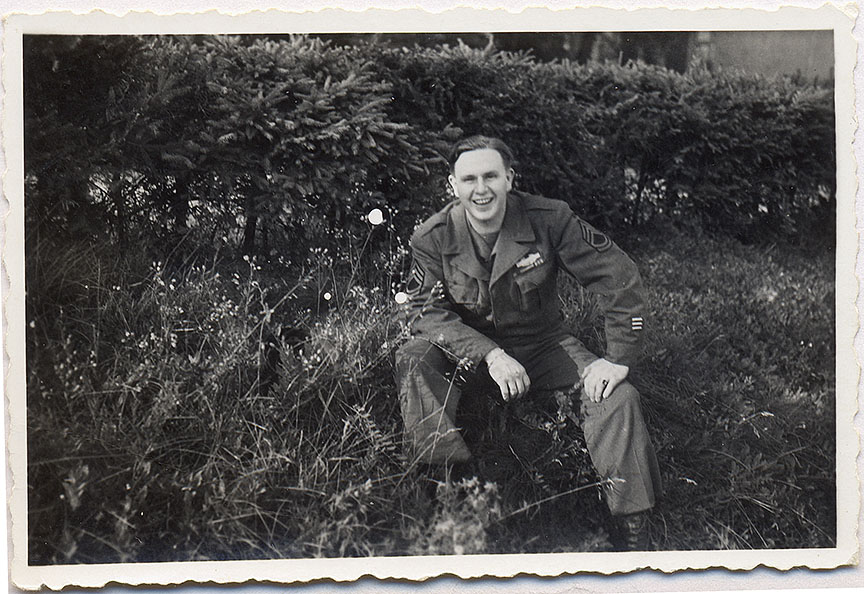
By the end of the war, Pete is thinner with a more loose fitting uniform but more service stripes. |
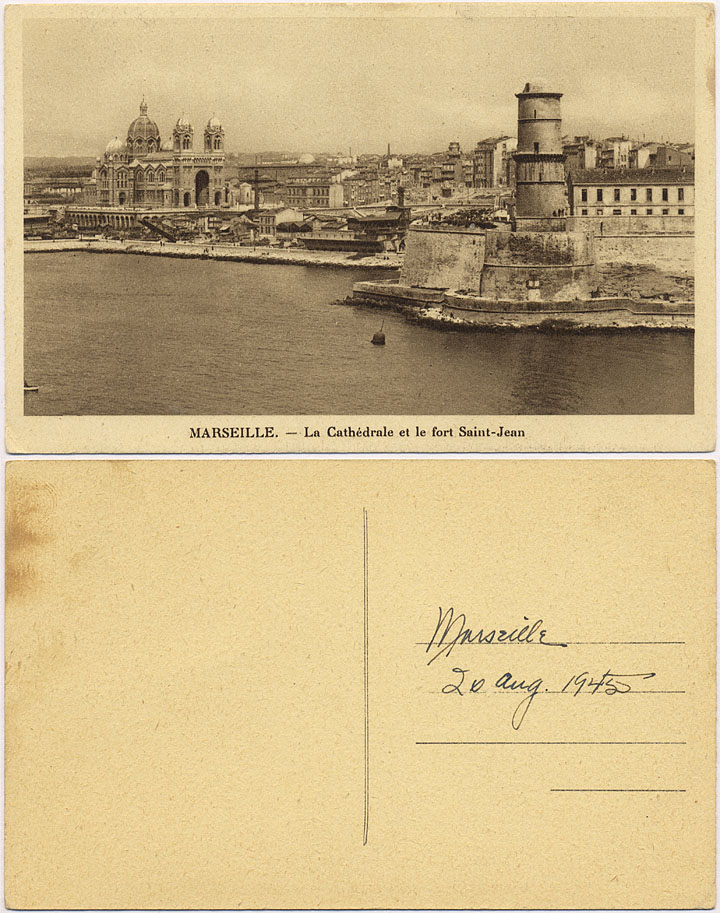
By summer time on August 20, 1945, Most likely on his way home, Pete takes a few side trips back in France at the port city of Marseille. |
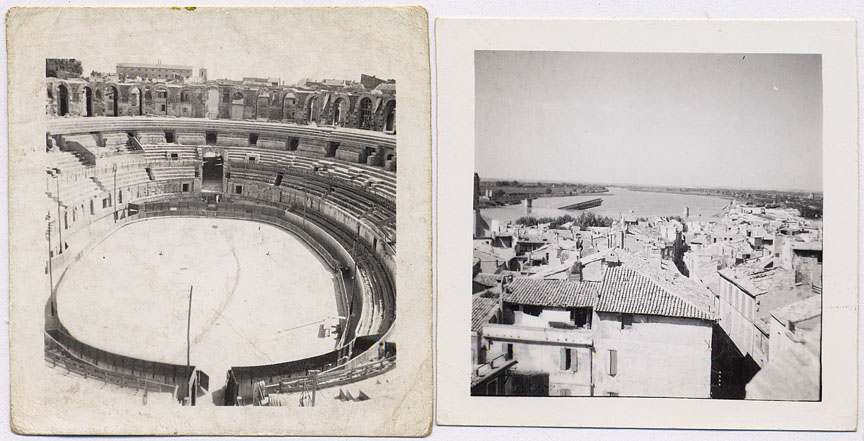
Northwest of Marseille, Pete photographs the views from the top of the Roman Colosseum at Arles. A UNESCO World Heritage site today, the amphitheater today is still in use and dates from 90 A.D. Notice the collapsed bridge in the Rhone River in the distance. |
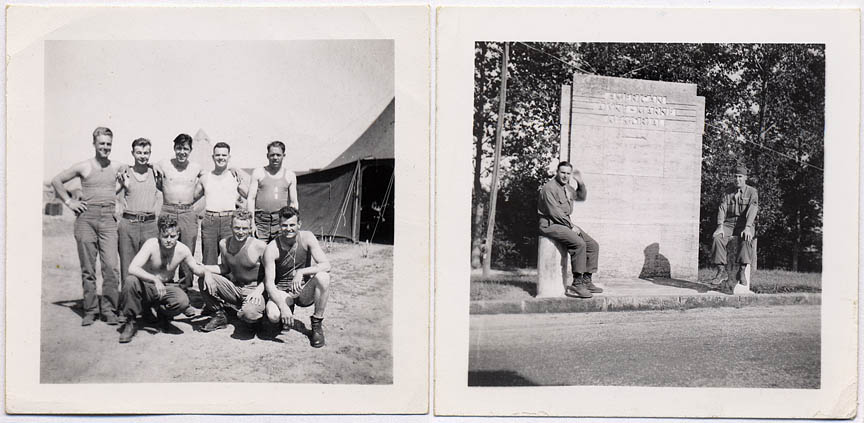
Northeast of Paris, Pete visits the Aisne - Marne WWI American Cemetery near Chateau-Thierry and some of his tent mates at camp. (Unfortunately, no descriptions or names were written on the back) |
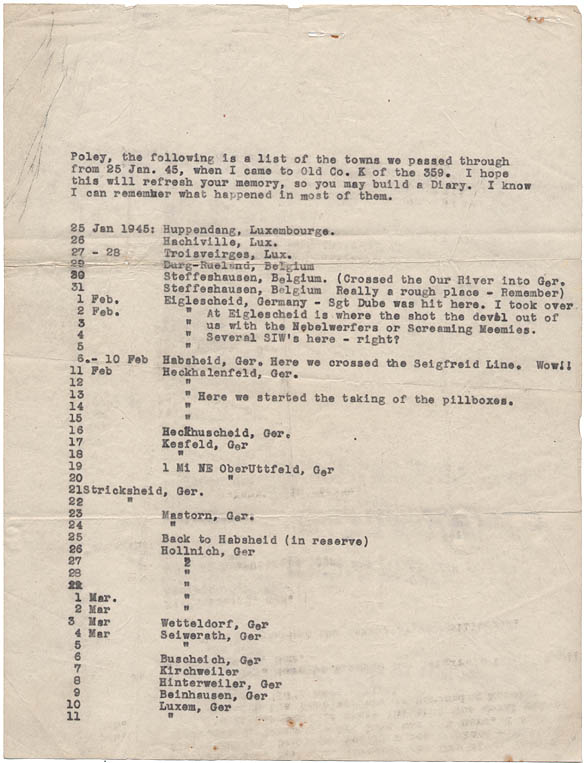
Willard Hurelle lists the towns Company 'K' 359 Infantry passed through from January 25, 1945 to May 7, 1945.
Notice, there was heavy combat in Eiglescheid, Germany.
Download the After Action Report PDF for January - May 1945.
|
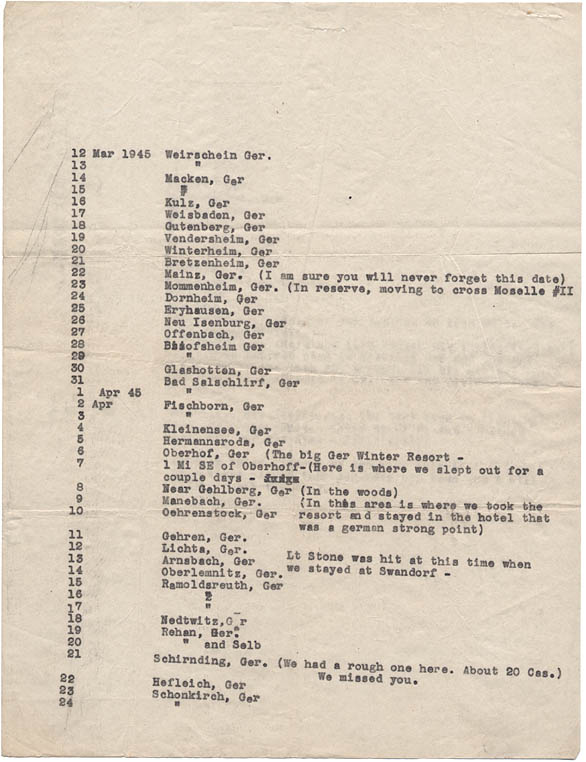
Page 2. Numerous casualties were taken by the 359 in Schirnding.
They camped in the woods and stayed at a captured German strong point hotel in Manebach, Germany and they passed through the destruction in Mainz, Germany - see photos above. |
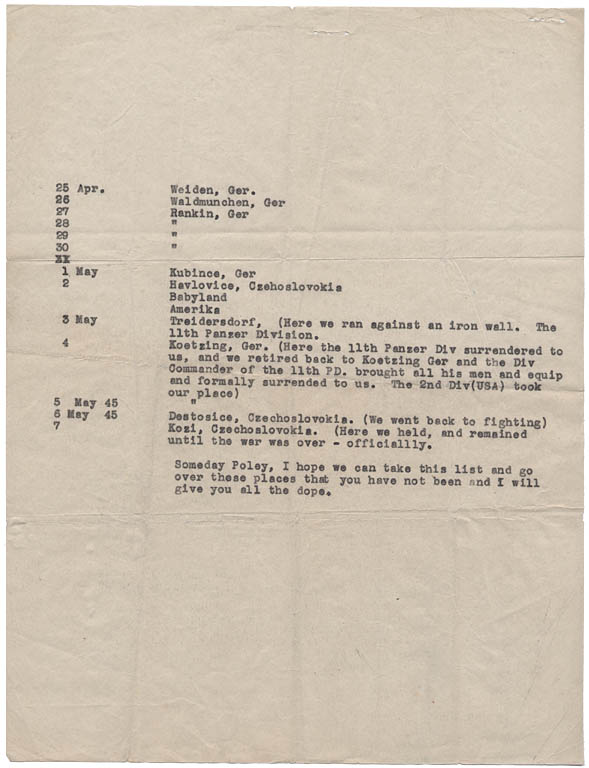
Page 3 - Notice the German 11th Panzer Division surrendered to the 359. |
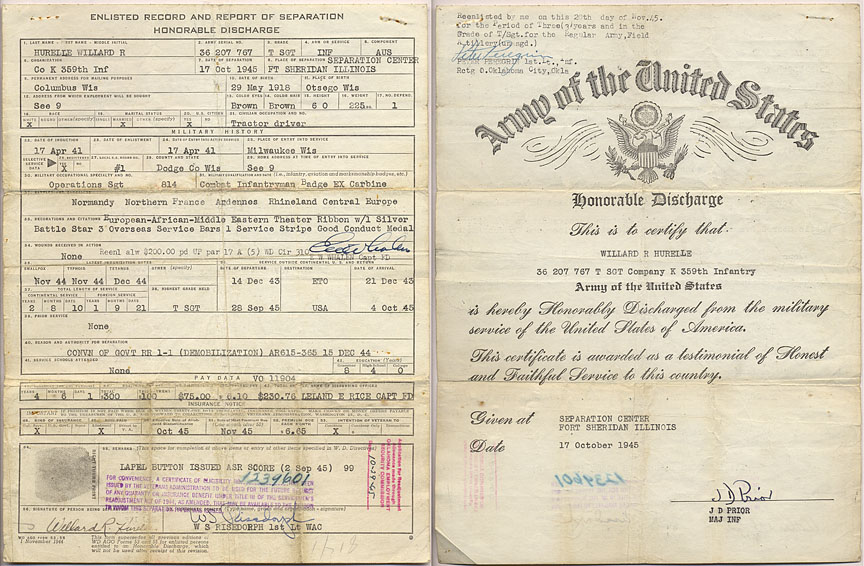
Willard's honorable discharge form from 1945 and reenlistment as T-Sgt for three more years on the back page. Pete's ASR or Adjusted Service Rating score was 99. An Army enlisted man needed at least 85 points to be considered for demobilization. Soldiers referred to the ASR as the "point system."
In Box 32, Battles and Campaigns, arrowheads listed after the campaign denote participation in an assault landings. Pete was not on any assault landings but according to his notes did see action throughout Belgium and Germany including the "taking of the pillboxes" in Heckhanlendfeld, Germany on February 13. In Eiglescheid, Germany on February 1st, 1945, when "Sgt. Dube was hit here. I took over." He continued "At Eiglescheid is where the(y) shot the devil out of us with the Nebelwerfers or screaming memmies" (15 cm Nebelwerfer 41 rocket launcher - mortar Allied soldiers dubbed screaming mimi for its distinctive sound). He also lists April 21st at Schirnding, Germany "we had a rough one here. About 20 cas. (casualties). |
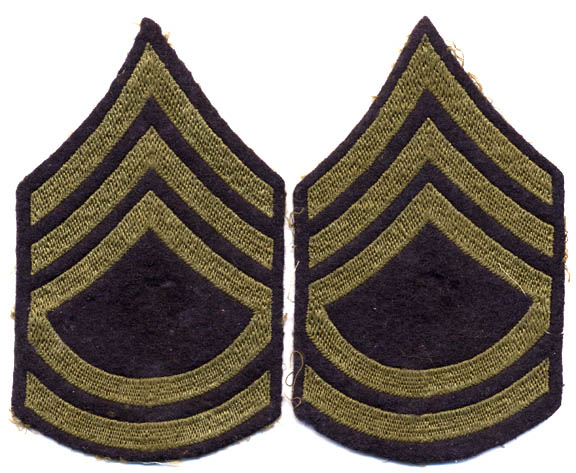
Willard's served as and Operations sergeant during WWII and a Army technical sergeant after. |
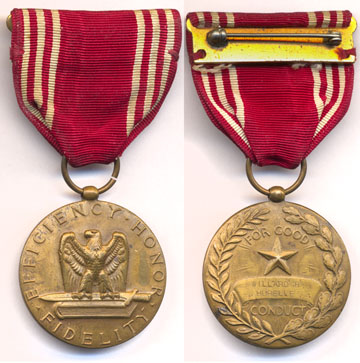
Willard Hurelle's Army Good Conduct Medal. (After three consecutive years of service, the medal was awarded on a selective basis to each Soldier who distinguished themselves from their fellow Soldiers by their exemplary conduct, efficiency, and fidelity) |
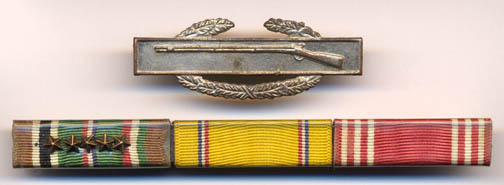
Willard served in the Army April 17, 1941 to October 17, 1945 in the European Theater of Operations as a Operations Sgt in Normandy, Northern France, Ardennes, Rhineland and Central Europe with the following badges:
- Combat infantryman Badge EX Carbine - The badge is awarded to infantrymen in the rank of colonel and below, who fought in active ground combat while assigned as members of Infantry unit of brigade size or smaller at any time after 6 December 1941. -- Also in the 90th, an officer in the 358th infantry, Major Burns commented in a letter after he received his Combat Infantryman Badge, that "...all of us consider it our highest award, above any other medal, for it is limited to front line fighting troops."
- European-African-Middle Eastern Theater Ribbon with five bronze Campaign stars representing five campaigns. (Five bronze Campaign stars are then represented by one Silver Battle Star)
- The yellow is a WWII US Army American Defense Service bar recognizing those military service members who had served on active duty between September 8, 1939, and December 7, 1941
- The red bar is the three year good conduct bar
|
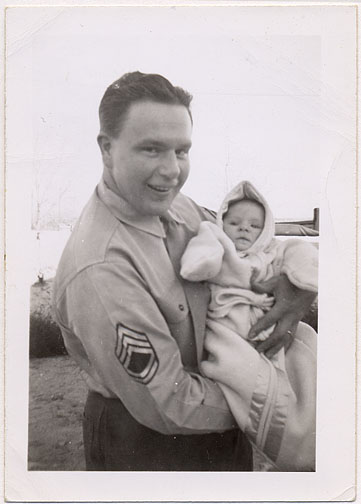 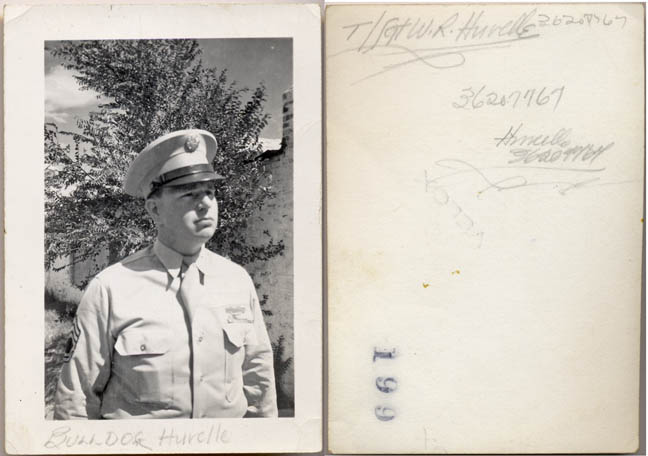
Pete's daughter Connie arrives and the "Bulldog" T/Sgt Investigator 301 now has a family to take care of in 1947. |

Pete's harmonicas he likely picked up after the war. The Koch Chromatic made in Germany dates from the late 1930's and the Opera harmonica was made in West Germany from 1948 to 1952 and has a price tag of $1.00 from Newberry, a closed U.S. retail store. |
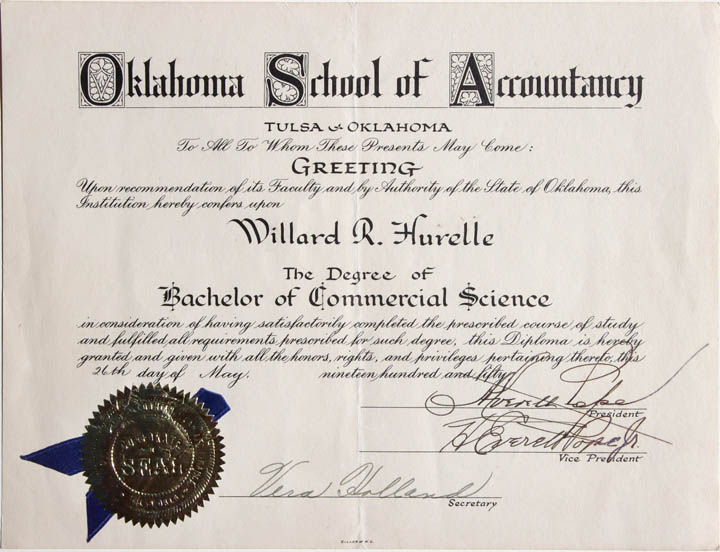 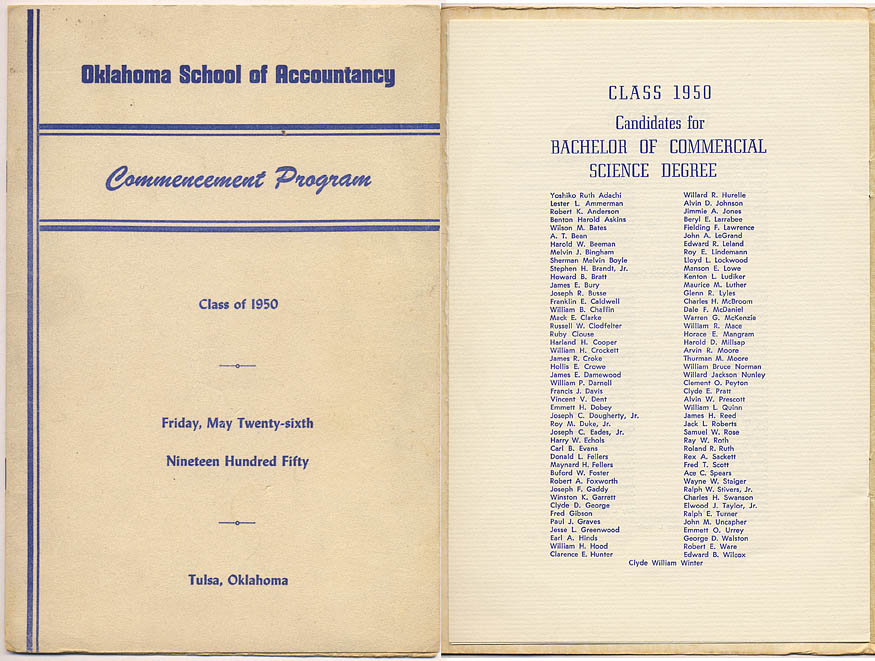
After the war and additional service in the States, Pete received 3 more years of accounting education with a Bachelor of Commercial Science Degree and eventually worked as an accountant at various locations including Independence, Kansas and Tulsa, Oklahoma and then moved to Seattle in 1954 to start a career at Boeing. |
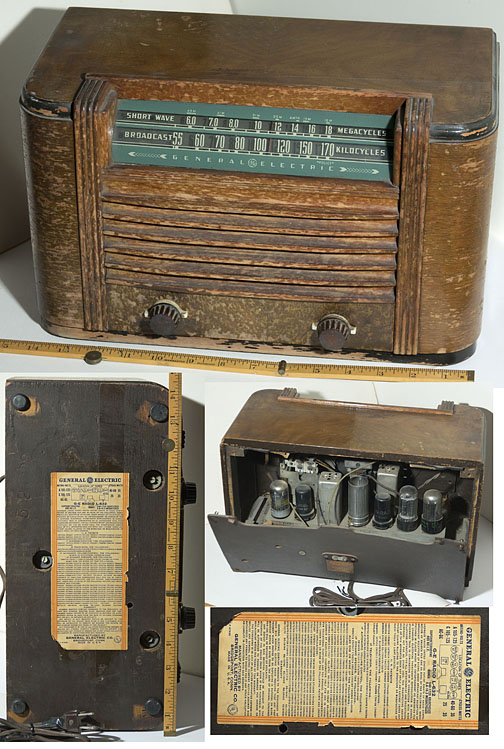
Pete's well used GE L-362 vacuum tube radio which also picked up shortwave frequencies. It was manufactured in 1942 with a cardboard back and brass push attachments to easily access the inside electronics to replace the tubes. |
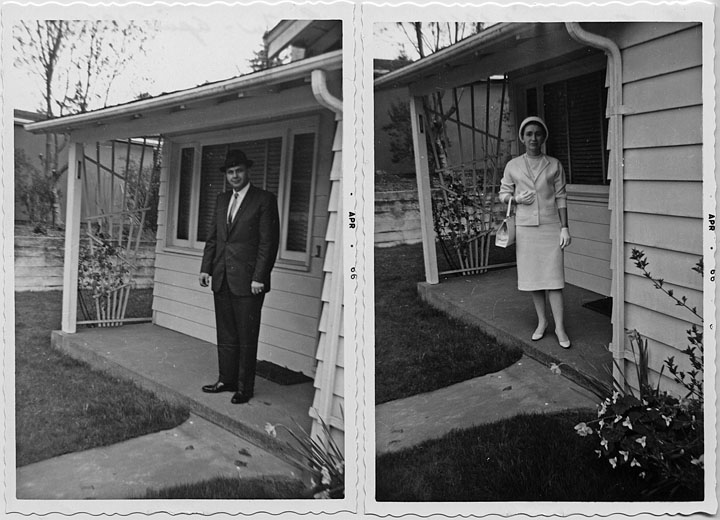
In April of 1966, Pete and Frieda get dressed up for Easter service at church while at their Seattle home. |
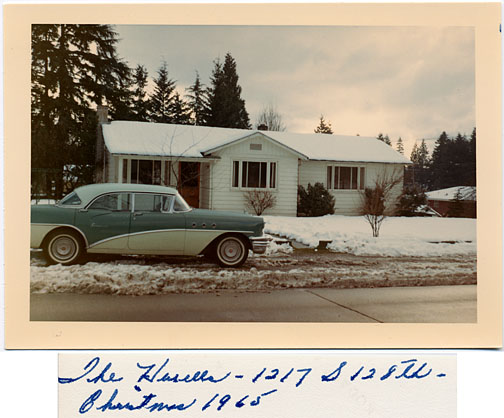
On December 25, 1965, snow covers the ground of their 1217 S. 128th address in Seattle. Parked out front, their 1955, four door hard top Buick Special with three "ventiports" on each side of the hood. |
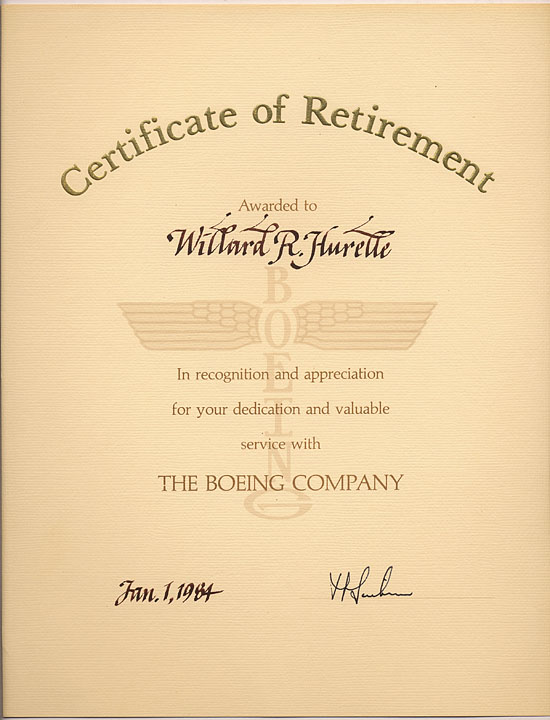 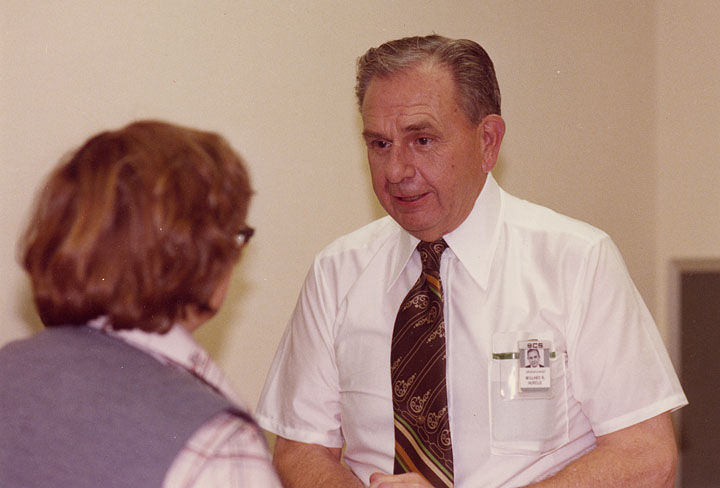
Pete, at 65 years old and after 29 years at Boeing employed as an accountant, systems analyst and general administrator worked his last day on December 23, 1983. |
Go to the Hurelle Family
|











